Qatar
Qatar (/ˈkætɑːr/,[10] /ˈkɑːtɑːr/ (![]() listen), /ˈkɑːtər/ or /kəˈtɑːr/ (
listen), /ˈkɑːtər/ or /kəˈtɑːr/ (![]() listen);[11] Arabic: قطر, romanized: Qaṭar [ˈqatˤar]; local vernacular pronunciation: [ˈɡɪtˤɑr]),[12][13] officially the State of Qatar,[lower-alpha 1] is a country in Western Asia. It occupies the small Qatar Peninsula on the northeastern coast of the Arabian Peninsula, and shares its sole land border with neighbouring Gulf Cooperation Council monarchy Saudi Arabia to the south, with the rest of its territory surrounded by the Persian Gulf. The Gulf of Bahrain, an inlet of the Persian Gulf, separates Qatar from nearby Bahrain. The capital is Doha, home to over 80% of the nation's population.
listen);[11] Arabic: قطر, romanized: Qaṭar [ˈqatˤar]; local vernacular pronunciation: [ˈɡɪtˤɑr]),[12][13] officially the State of Qatar,[lower-alpha 1] is a country in Western Asia. It occupies the small Qatar Peninsula on the northeastern coast of the Arabian Peninsula, and shares its sole land border with neighbouring Gulf Cooperation Council monarchy Saudi Arabia to the south, with the rest of its territory surrounded by the Persian Gulf. The Gulf of Bahrain, an inlet of the Persian Gulf, separates Qatar from nearby Bahrain. The capital is Doha, home to over 80% of the nation's population.
State of Qatar | |
|---|---|
Flag
 Emblem
| |
| Motto: الله الوطن الأمير God, Nation, Emir | |
| Anthem: السلام الأميري As-Salām al-ʾAmīrī (transliteration) "Peace to the Emir" | |
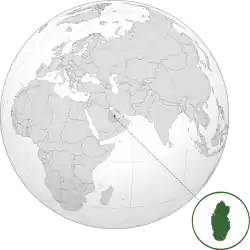 Location and extent of Qatar (dark green) on the Arabian Peninsula | |
| Capital and largest city | Doha 25°18′N 51°31′E |
| Official languages | Arabic[1] |
| Common languages | English |
| Ethnic groups (2015)[2] |
|
| Religion (2020)[3] |
|
| Demonym(s) | Qatari |
| Government | Unitary Islamic parliamentary semi-constitutional monarchy |
• Emir | Tamim bin Hamad |
• Prime Minister | Khalid bin Khalifa |
| Legislature | Consultative Assembly |
| Establishment | |
• Qatar National Day | 18 December 1878 |
• Declared independence | 1 September 1971 |
• Independence from the United Kingdom | 3 September 1971 |
| Area | |
• Total | 11,581 km2 (4,471 sq mi) (158th) |
• Water (%) | 0.8 |
| Population | |
• 2020 estimate | 2,795,484[4] (139th) |
• 2010 census | 1,699,435[5] |
• Density | 176/km2 (455.8/sq mi) (76th) |
| GDP (PPP) | 2022 estimate |
• Total | |
• Per capita | |
| GDP (nominal) | 2022 estimate |
• Total | |
• Per capita | |
| Gini (2007) | 41.1[7] medium |
| HDI (2021) | very high · 42nd |
| Currency | Qatari riyal (QAR) |
| Time zone | UTC+3 (AST) |
| Driving side | right[9] |
| Calling code | +974 |
| ISO 3166 code | QA |
| Internet TLD |
|
Qatar has been ruled as a hereditary monarchy by the House of Thani since Mohammed bin Thani signed a treaty with the British in 1868 that recognised its separate status. Following Ottoman rule, Qatar became a British protectorate in the early 20th century until gaining independence in 1971. The current emir is Tamim bin Hamad Al Thani, who holds nearly all executive and legislative authority under the Constitution of Qatar, as well as controlling the judiciary.[14] He appoints the prime minister and cabinet. The partially-elected Consultative Assembly can block legislation and has a limited ability to dismiss ministers.
In early 2017, Qatar's total population was 2.6 million, with 313,000 of them Qatari citizens and 2.3 million expatriates.[15] Its official religion is Islam.[16] In terms of income, the country has the fourth-highest GDP (PPP) per capita in the world,[17] and the sixth-highest GNI per capita (Atlas method).[18] Qatar has the third-highest HDI in the Arab world.[19] It is a high-income economy, backed by the world's third-largest natural gas reserves and oil reserves.[20] Qatar is one of the world's largest exporters of liquefied natural gas,[21] and the world's largest emitter of carbon dioxide per capita.[22]
In the 21st century, Qatar emerged as a middle power in the Arab world through its resource-wealth,[23][24] as well as its globally expanding media group, Al Jazeera Media Network, and reportedly supporting several rebel groups financially during the Arab Spring.[25][26][27] Qatar's human rights record has been regarded by academics and non-governmental organisations as being generally poor, with restrictions on civil liberties such as the freedoms of association, expression and the press, as well as its treatment of thousands of migrant workers amounting to forced labour for projects in the country.[28][29] The 2022 FIFA World Cup was awarded to Qatar under controversial circumstances, making it the first Muslim country in the Arab world to host the event.[30] Qatar hosted the 2006 Asian Games, and will also host the 2030 Asian Games.[31]
Etymology
Pliny the Elder, a Roman writer, documented the earliest account pertaining to the inhabitants of the peninsula around the mid-first century AD, referring to them as the Catharrei, a designation which may have derived from the name of a prominent local settlement.[32][33] A century later, Ptolemy produced the first known map to depict the peninsula, referring to it as Catara.[33][34] The map also referenced a town named "Cadara" to the east of the peninsula.[35] The term 'Catara' (inhabitants, Cataraei)[36] was exclusively used until the 18th century, after which 'Katara' emerged as the most commonly recognised spelling.[35] Eventually, after several variations – 'Katr', 'Kattar' and 'Guttur' – the modern derivative Qatar was adopted as the country's name.[37]
In Standard Arabic, the name is pronounced [ˈqɑtˤɑr], while in the local dialect it is [ˈɡitˤar].[12]
History
Antiquity
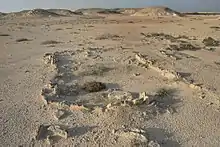
Human habitation of Qatar dates back to 50,000 years ago.[38] Settlements and tools dating back to the Stone Age have been unearthed in the peninsula.[38] Mesopotamian artifacts originating from the Ubaid period (c. 6500–3800 BC) have been discovered in abandoned coastal settlements.[39] Al Da'asa, a settlement located on the western coast of Qatar, is the most important Ubaid site in the country and is believed to have accommodated a small seasonal encampment.[40][41]
Kassite Babylonian material dating back to the second millennium BC found in Al Khor Islands attests to trade relations between the inhabitants of Qatar and the Kassites in modern-day Bahrain.[42] Among the findings were 3,000,000 crushed snail shells and Kassite potsherds.[40] It has been suggested that Qatar is the earliest known site of shellfish dye production, owing to a Kassite purple dye industry which existed on the coast.[39][43]
In 224 AD, the Sasanian Empire gained control over the territories surrounding the Persian Gulf.[44] Qatar played a role in the commercial activity of the Sasanids, contributing at least two commodities: precious pearls and purple dye.[45] Under the Sasanid reign, many of the inhabitants in Eastern Arabia were introduced to Christianity following the eastward dispersal of the religion by Mesopotamian Christians.[46] Monasteries were constructed and further settlements were founded during this era.[47][48] During the latter part of the Christian era, Qatar comprised a region known as 'Beth Qatraye' (Syriac for "house of the Qataris").[49] The region was not limited to Qatar; it also included Bahrain, Tarout Island, Al-Khatt, and Al-Hasa.[50]
In 628, Muhammad sent a Muslim envoy to a ruler in Eastern Arabia named Munzir ibn Sawa Al Tamimi and requested that he and his subjects accept Islam. Munzir obliged his request, and accordingly, most of the Arab tribes in the region converted to Islam.[51] In the middle of the century, the Muslim conquest of Persia would result in the fall of the Sasanian Empire.[52]
Early and late Islamic period (661–1783)
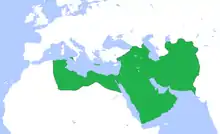
Qatar was described as a famous horse and camel breeding centre during the Umayyad period.[53] In the 8th century, it started benefiting from its commercially strategic position in the Persian Gulf and went on to become a centre of pearl trading.[54][55]
Substantial development in the pearling industry around the Qatari Peninsula occurred during the Abbasid era.[53] Ships voyaging from Basra to India and China would make stops in Qatar's ports during this period. Chinese porcelain, West African coins and artefacts from Thailand have been discovered in Qatar.[52] Archaeological remains from the 9th century suggest that Qatar's inhabitants used greater wealth to construct higher quality homes and public buildings. Over 100 stone-built houses, two mosques, and an Abbasid fort were constructed in Murwab during this period.[56][57] When the caliphate's prosperity declined in Iraq, so too did it in Qatar.[58] Qatar is mentioned in 13th-century Muslim scholar Yaqut al-Hamawi's book, Mu'jam Al-Buldan, which alludes to the Qataris' fine striped woven cloaks and their skills in improvement and finishing of spears.[59]
Much of Eastern Arabia was controlled by the Usfurids in 1253, but control of the region was seized by the prince of Ormus in 1320.[60] Qatar's pearls provided the kingdom with one of its main sources of income.[61] In 1515, Manuel I of Portugal vassalised the Kingdom of Ormus. Portugal went on to seize a significant portion of Eastern Arabia in 1521.[61][62] In 1550, the inhabitants of Al-Hasa voluntarily submitted to the rule of the Ottomans, preferring them to the Portuguese.[63] Having retained a negligible military presence in the area, the Ottomans were expelled by the Bani Khalid tribe in 1670.[64]
Bahraini and Saudi rule (1783–1868)
_1794_(cropped).jpg.webp)
In 1766, members of the Al Khalifa family of the Utub tribal confederation migrated from Kuwait to Zubarah in Qatar.[65][66] By the time of their arrival, the Bani Khalid exercised weak authority over the peninsula, notwithstanding the fact that the largest village was ruled by their distant kin.[67] In 1783, Qatar-based Bani Utbah clans and allied Arab tribes invaded and annexed Bahrain from the Persians. The Al Khalifa imposed their authority over Bahrain and retained their jurisdiction over Zubarah.[65]
%252C_ruined_city.JPG.webp)
Following his swearing in as crown prince of the Wahhabi in 1788, Saud ibn Abd al-Aziz moved to expand Wahhabi territory eastward towards the Persian Gulf and Qatar. After defeating the Bani Khalid in 1795, the Wahhabi were attacked on two fronts. The Ottomans and Egyptians assaulted the western front, while the Al Khalifa in Bahrain and the Omanis launched an attack against the eastern front.[68][69] Upon being made aware of the Egyptian advance on the western frontier in 1811, the Wahhabi amir reduced his garrisons in Bahrain and Zubarah in order to redeploy his troops. Said bin Sultan, ruler of Muscat, capitalised on this opportunity and raided the Wahhabi garrisons on the eastern coast, setting fire to the fort in Zubarah. The Al Khalifa were effectively returned to power thereafter.[69]
As punishment for piracy, an East India Company vessel bombarded Doha in 1821, destroying the town and forcing hundreds of residents to flee. In 1825, the House of Thani was established with Sheikh Mohammed bin Thani as the first leader.[70]
Although Qatar was considered a dependency of Bahrain, the Al Khalifa faced opposition from the local tribes. In 1867, the Al Khalifa, along with the ruler of Abu Dhabi, sent a massive naval force to Al Wakrah in an effort to crush the Qatari rebels. This resulted in the maritime Qatari–Bahraini War of 1867–1868, in which Bahraini and Abu Dhabi forces sacked and looted Doha and Al Wakrah.[71] The Bahraini hostilities were in violation of the Perpetual Truce of Peace and Friendship of 1861. The joint incursion, in addition to the Qatari counter-attack, prompted British Political Resident, Colonel Lewis Pelly to impose a settlement in 1868. His mission to Bahrain and Qatar and the resulting peace treaty were milestones because they implicitly recognised the distinctness of Qatar from Bahrain and explicitly acknowledged the position of Mohammed bin Thani. In addition to censuring Bahrain for its breach of agreement, Pelly negotiated with Qatari sheikhs, who were represented by Mohammed bin Thani.[72] The negotiations were the first stage in the development of Qatar as a sheikhdom.[73] However, Qatar was not officially recognised as a British protectorate until 1916.[74]
The Ottoman period (1871–1915)
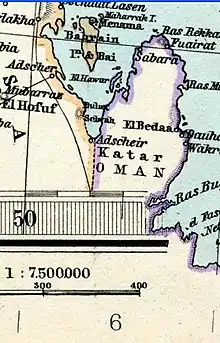
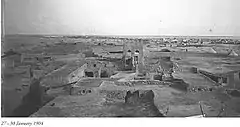
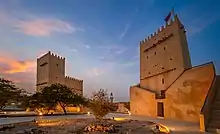
Under military and political pressure from the governor of the Ottoman Vilayet of Baghdad, Midhat Pasha, the ruling Al Thani tribe submitted to Ottoman rule in 1871.[75] The Ottoman government imposed reformist (Tanzimat) measures concerning taxation and land registration to fully integrate these areas into the empire.[75] Despite the disapproval of local tribes, Al Thani continued supporting Ottoman rule. Qatari-Ottoman relations, however, soon stagnated, and in 1882 they suffered further setbacks when the Ottomans refused to aid Al Thani in his expedition of Abu Dhabi-occupied Khawr al Udayd. In addition, the Ottomans supported the Ottoman subject Mohammed bin Abdul Wahab who attempted to supplant Al Thani as kaymakam of Qatar in 1888.[76] This eventually led Al Thani to rebel against the Ottomans, whom he believed were seeking to usurp control of the peninsula. He resigned as kaymakam and stopped paying taxes in August 1892.[77]
In February 1893, Mehmed Hafiz Pasha arrived in Qatar in the interests of seeking unpaid taxes and accosting Jassim bin Mohammed's opposition to proposed Ottoman administrative reforms. Fearing that he would face death or imprisonment, Jassim retreated to Al Wajbah (16 km or 10 mi west of Doha), accompanied by several tribe members. Mehmed's demand that Jassim disbands his troops and pledge his loyalty to the Ottomans was met with refusal. In March, Mehmed imprisoned Jassim's brother and 13 prominent Qatari tribal leaders on the Ottoman corvette Merrikh as punishment for his insubordination. After Mehmed declined an offer to release the captives for a fee of 10,000 liras, he ordered a column of approximately 200 troops to advance towards Jassim's Al Wajbah Fort under the command of Yusuf Effendi, thus signalling the start of the Battle of Al Wajbah.[52]
Effendi's troops came under heavy gunfire by a sizable troop of Qatari infantry and cavalry shortly after arriving at Al Wajbah. They retreated to Shebaka fortress, where they were again forced to draw back from a Qatari incursion. After they withdrew to Al Bidda fortress, Jassim's advancing column besieged the fortress, resulting in the Ottomans' concession of defeat and agreement to relinquish their captives in return for the safe passage of Mehmed Pasha's cavalry to Hofuf by land.[78] Although Qatar did not gain full independence from the Ottoman Empire, the result of the battle forced a treaty that would later form the basis of Qatar's emerging as an autonomous country within the empire.[79]
British period (1916–1971)
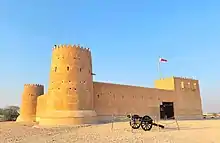
By the Anglo-Turkish Convention of 1913, the Ottomans agreed to renounce their claim to Qatar and withdraw their garrison from Doha. However, with the outbreak of World War I, nothing was done to carry this out and the garrison remained in the fort at Doha, although its numbers dwindled as men deserted. In 1915, with the presence of British gunboats in the harbour, Abdullah bin Jassim Al Thani (who was pro-British) persuaded the remainder to abandon the fort and, when British troops approached the following morning, they found it deserted.[80][81]
Qatar became a British protectorate on 3 November 1916, when the United Kingdom signed a treaty with Sheikh Abdullah bin Jassim Al Thani to bring Qatar under its Trucial System of Administration. While Abdullah agreed not to enter into any relations with any other power without prior consent of the British government, the latter guaranteed the protection of Qatar from aggression by sea and provide its 'good offices' in the event of an attack by land – this latter undertaking was left deliberately vague.[80][82] On 5 May 1935, while agreeing an oil concession with the British oil company, the Anglo-Persian Oil Company, Abdullah signed another treaty with the British government which granted Qatar protection against internal and external threats.[80] Oil reserves were first discovered in 1939. Exploitation and development were, however, delayed by World War II.[83]
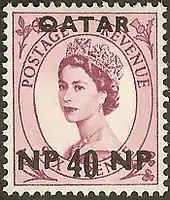
The focus of British interests in Qatar changed after the Second World War with the independence of India, the creation of Pakistan in 1947 and the development of oil in Qatar. In 1949, the appointment of the first British political officer in Doha, John Wilton, signifed a strengthening of Anglo-Qatari relations.[84] Oil exports began in 1949, and oil revenues became the country's main source of revenue, the pearl trade having gone into decline. These revenues were used to fund the expansion and modernisation of Qatar's infrastructure. When Britain officially announced in 1968 that it would withdraw from the Persian Gulf in three years' time, Qatar joined talks with Bahrain and seven other Trucial States to create a federation. Regional disputes, however, persuaded Qatar and Bahrain to withdraw from the talks and become independent states separate from the Trucial States, which went on to become the United Arab Emirates.
Independence and aftermath (1971–present)
On 3 November 1916, the sheikh of Qatar entered into treaty relations with the United Kingdom.[85] The treaty reserved foreign affairs and defence to the United Kingdom but allowed internal autonomy. On 3 September 1971, those "special treaty arrangements" that were "inconsistent with full international responsibility as a sovereign and independent state" were terminated.[86] This was done under an agreement reached between the Ruler of Qatar and the Government of the United Kingdom.[87][86]
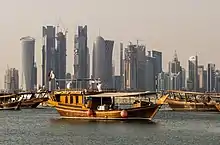
In 1991, Qatar played a significant role in the Gulf War, particularly during the Battle of Khafji in which Qatari tanks rolled through the streets of the town and provided fire support for Saudi Arabian National Guard units that were engaging Iraqi Army troops. Qatar allowed coalition troops from Canada to use the country as an airbase to launch aircraft on CAP duty and also permitted air forces from the United States and France to operate in its territories.[38]
In 1995, Emir Hamad bin Khalifa Al Thani seized control of the country from his father Khalifa bin Hamad Al Thani, with the support of the armed forces and cabinet, as well as neighbouring states[88] and France.[89] Under Emir Hamad, Qatar experienced a moderate degree of liberalisation, including the launch of the Al Jazeera television station (1996), the endorsement of women's suffrage or right to vote in municipal elections (1999), drafting its first written constitution (2005) and inauguration of a Roman Catholic church (2008). In 2010, Qatar won the rights to host the 2022 FIFA World Cup, making it the first country in the Middle East to be selected to host the tournament. The Emir announced Qatar's plans to hold its first national legislative elections in 2013. They were scheduled to be held in the second half of 2013, but were postponed until October 2021. The legislative council hosted the 140th Inter-Parliamentary Union Assembly for the first time in April 2019.[90]
In 2003, Qatar served as the US Central Command headquarters and one of the main launching sites of the invasion of Iraq.[91] In March 2005, a suicide bombing killed a British teacher from Dorset called Jonathan Adams[92] at the Doha Players Theatre, shocking the country, which had not previously experienced acts of terrorism. The bombing was carried out by Omar Ahmed Abdullah Ali, an Egyptian resident in Qatar who had suspected ties to Al-Qaeda in the Arabian Peninsula.[93][94] In 2011, Qatar joined NATO operations in Libya and reportedly armed Libyan opposition groups.[95] It is also currently a major funder of weapons for rebel groups in the Syrian civil war.[96] Qatar is pursuing an Afghan peace deal and in January 2012 the Afghan Taliban said they were setting up a political office in Qatar to facilitate talks. This was done in order to facilitate peace negotiations and with the support of other countries including the United States and Afghanistan. Ahmed Rashid, writing in the Financial Times, stated that through the office Qatar has "facilitated meetings between the Taliban and many countries and organisations, including the US state department, the UN, Japan, several European governments and non-governmental organisations, all of whom have been trying to push forward the idea of peace talks." the article also claimed that suggestions in September 2017 by the presidents of both the United States and Afghanistan reportedly led to protests from senior officials of the American State Department.[97]
In June 2013, Sheikh Tamim bin Hamad Al Thani became the Emir of Qatar after his father handed over power in a televised speech.[98] Sheikh Tamim has prioritised improving the domestic welfare of citizens, which includes establishing advanced healthcare and education systems, and expanding the country's infrastructure in preparation for the hosting of the 2022 World Cup.[99]
Qatar participated in the Saudi Arabian-led intervention in Yemen against the Houthis and forces loyal to former President Ali Abdullah Saleh, who was deposed in the 2011 Arab Spring uprisings.[100]
The increased influence of Qatar and its role during the Arab Spring, especially during the Bahraini uprising in 2011, worsened longstanding tensions with Saudi Arabia, the neighboring United Arab Emirates (UAE), and Bahrain. In June 2017, Egypt, Saudi Arabia, United Arab Emirates, and Bahrain cut off diplomatic relations with Qatar, citing the country's alleged support of groups they considered to be extremist.[101] This has resulted in increased Qatari economic and military ties with Turkey and Iran.
Qatar is expected to host the 2022 FIFA World Cup from 21 November to 18 December, becoming the first Arab country to do so.[102]
Politics
_(cropped).jpg.webp)
Emir since 2013
.jpg.webp)
Prime Minister since 2020
Qatar is officially a semi-constitutional monarchy,[103][104] but the wide powers retained by the monarchy have it still bordering an absolute monarchy[105][106] ruled by the Al Thani family.[107][108] The Al Thani dynasty has been ruling Qatar since the family house was established in 1825.[2] In 2003, Qatar adopted a constitution that provided for the direct election of 30 of the 45 members of a legislature.[2][109][110] The constitution was overwhelmingly approved in a referendum, with almost 98% in favour.[111][112]
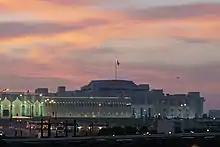
The eighth Emir of Qatar is Tamim bin Hamad Al Thani, whose father Hamad bin Khalifa Al Thani handed power to him on 25 June 2013.[113] The Emir has the exclusive power to appoint the prime minister and cabinet ministers who, together, constitute the Council of Ministers, which is the supreme executive authority in the country.[114] The Council of Ministers also initiates legislation.[114]
The Consultative Assembly is made up of 30 popularly-elected members and 15 appointed by the emir. It can block legislation with a simple majority, and can dismiss ministers, including the prime minister, with a two-thirds vote. The assembly had its first elections in October 2021 after several postponements.[115][116][117]
Qatari law does not permit the establishment of political bodies or trade unions.[118]
Law
According to Qatar's Constitution, Sharia law is the main source of Qatari legislation,[119][120] although in practice, Qatar's legal system is a mixture of civil law and Sharia law.[121][122] Sharia law is applied to family law, inheritance, and several criminal acts (including adultery, robbery and murder). In some cases, Sharia-based family courts treat a female's testimony as being worth half that of a man.[123] Codified family law was introduced in 2006. Islamic polygyny is permitted.[89]
Judicial corporal punishment is a punishment in Qatar. Flogging is employed as a punishment for alcohol consumption or illicit sexual relations.[124] Article 88 of Qatar's criminal code declares that the penalty for adultery is 100 lashes,[125] and in 2006, a Filipino woman was sentenced that punishment.[125] In 2010, at least 18 people (mostly foreign nationals) were sentenced to receive between 40 and 100 lashes for offences involving "illicit sexual relations" or alcohol consumption.[126] In 2011, at least 21 people (mostly foreign nationals) were sentenced to between 30 and 100 lashes for the same reasons,[127] and in 2012, six expatriates were sentenced to either 40 or 100 lashes.[124] Only Muslims considered medically fit are liable to have such sentences carried out. In April 2013, a Muslim expatriate was sentenced to 40 lashes for alcohol consumption,[128][129][130] and in June 2014, a Muslim expatriate was sentenced to 40 lashes for consuming alcohol and driving under the influence.[131]
Stoning is a legal punishment in Qatar,[132] and apostasy and homosexuality are crimes punishable by the death penalty; however, the penalty has not been carried out for either crime.[133][134] Blasphemy can result in up to seven years in prison, while proselytising can incur a 10-year sentence.[133][135]
Alcohol consumption is partially legal in Qatar; some five-star luxury hotels are allowed to sell alcohol to their non-Muslim customers.[136][137] Muslims are not allowed to consume alcohol, and those caught consuming it are liable to flogging or deportation. Non-Muslim expatriates can obtain a permit to purchase alcohol for personal consumption. The Qatar Distribution Company (a subsidiary of Qatar Airways) is permitted to import alcohol and pork; it operates the one and only liquor store in the country, which also sells pork to holders of liquor licences.[138][139] Qatari officials have also indicated a willingness to allow alcohol in "fan zones" at the 2022 FIFA World Cup.[140]
Until 2011, restaurants on the Pearl-Qatar (a man-made island near Doha) were allowed to serve alcoholic drinks.[136][137] In December 2011, however, Pearl restaurants were told to stop selling alcohol.[136][141] No explanation was given for the ban,[136][137] though speculation included encouraging a more pious image before a significant election and rumours of a financial dispute between the government and resort developers.[141] The alcohol ban was later lifted.[142]
In 2014, a modesty campaign was launched to remind tourists of the country's restrictive dress code.[143] Female tourists were advised not to wear leggings, miniskirts, sleeveless dresses, or short or tight clothing in public. Men were warned against wearing only shorts and singlets.[144]
Foreign relations
.jpg.webp)
Qatar's international profile and active role in international affairs has led some analysts to identify it as a middle power. Qatar was an early member of OPEC and a founding member of the Gulf Cooperation Council (GCC). It is a member of the Arab League.[2] Diplomatic missions to Qatar are based in its capital, Doha.
Qatar's regional relations and foreign policies are characterized by strategy of balancing and alliance building among regional and great powers. It maintains independent foreign policy and engages in regional balancing to secure its strategic priorities and to have recognition on the regional and international level.[145][146][147] As a small state in the gulf, Qatar established an "open-door" foreign policy where Qatar maintains ties to all parties and regional players in the region, including with organizations such as Taliban and Hamas.[148] The history of Qatar's alliances provides insight into the basis of its foreign relations. Between 1760 and 1971, Qatar sought formal protection from the high transitory powers of the Ottomans, British, the Al-Khalifas from Bahrain, and from Saudi Arabia.[149]
Qatar has particularly strong ties with China,[150] Iran,[151] Turkey,[152] and the United States[153] as well as a number of Islamist movements in the Middle East such as the Muslim Brotherhood.[154][145][155] In June 2017, Saudi Arabia, the UAE, Bahrain, Egypt and Yemen broke diplomatic ties with Qatar, accusing Qatar of supporting terrorism.[156] The crisis escalated a dispute over Qatar's support of the Muslim Brotherhood, which is considered a terrorist organization by some Arab nations.[157] The diplomatic crisis ended in January 2021 with the signing of AlUla declaration.[158]
Military

The Qatar Armed Forces are the military forces of Qatar. The country maintains a modest military force of approximately 11,800 men, including an army (8,500), navy (1,800) and air force (1,500). Qatar's defense expenditures accounted for approximately 4.2% of gross national product in 1993, and 1.5% of gross domestic product in 2010, the most recent year available in the SIPRI statistical database.[159] Qatar has recently signed defense pacts with the United States and United Kingdom, as well as with France earlier in 1994. Qatar plays an active role in the collective defense efforts of the Gulf Cooperation Council; the other five members are Saudi Arabia, Kuwait, Bahrain, the UAE, and Oman. The presence of the large Al Udeid Air Base, operated by the United States and several other UN nations, provides a guaranteed source of defense and national security. In 2008 Qatar spent US$2.3 billion on military expenditures, 2.3% of the gross domestic product.[160] Qatari special forces have been trained by France and other Western countries, and are believed to possess considerable skill.[161] They also helped the Libyan rebels during the 2011 Battle of Tripoli.[161]
The Stockholm International Peace Research Institute (SIPRI) found that in 2010–14 Qatar was the 46th-largest arms importer in the world. SIPRI writes that Qatar's plans to transform and significantly enlarge its armed forces have accelerated. Orders in 2013 for 62 tanks and 24 self-propelled guns from Germany were followed in 2014 by a number of other contracts, including 24 combat helicopters and 3 early-warning-and-control aircraft from the US, and 2 tanker aircraft from Spain.[162] In 2015, Qatar was the 16th largest arms importer in the world, and in 2016, it was the 11th largest, according to SIPRI.[163]
Qatar's military participated in the Saudi Arabian-led intervention in Yemen against the Shia Houthis. In 2015, Al Jazeera America reported: "Numerous reports suggest that the Saudi-led coalition against opposition groups in Yemen has indiscriminately attacked civilians and used cluster bombs in civilian-populated areas, in violation of international law."[164] Many civilians have been killed and the large parts of the infrastructure in this region is now destroyed.[165] Hospitals have also been bombed by the Saudis and those operating with them.[166][167] Qatar was suspended from the coalition in Yemen due to the 2017 Qatar diplomatic crisis.
Human rights
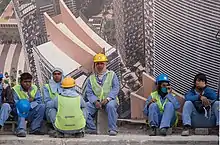
As of 2014, certain provisions of the Qatari Criminal Code allows punishments such as flogging and stoning to be imposed as criminal sanctions. The UN Committee Against Torture found that these practices constituted a breach of the obligations imposed by the UN Convention Against Torture.[168][169] Qatar retains the death penalty, mainly for threats against national security such as terrorism. The use of the death penalty is rare and no state executions have taken place in Qatar since 2003.[170] In Qatar, homosexual acts are illegal and can be punished by death.[171]
A 2011 report by the U.S. State Department concluded that some expatriate workers from nations throughout Asia and parts of Africa who voluntarily migrated to Qatar as low-skilled labourers or domestic servants subsequently faced conditions indicative of involuntary servitude. Some of the more common labour rights violations include beatings, withholding of payment, charging workers for benefits for which the employer is responsible, restrictions on freedom of movement (such as the confiscation of passports, travel documents, or exit permits), arbitrary detention, threats of legal action, and sexual assault.[172] Many migrant workers arriving for work in Qatar have paid exorbitant fees to recruiters in their home countries.[172]
Under the provisions of Qatar's sponsorship law, sponsors had the unilateral power to cancel workers' residency permits, deny workers' ability to change employers, report a worker as "absconded" to police authorities, and deny permission to leave the country.[172] As a result, sponsors may restrict workers' movements and workers may be afraid to report abuses or claim their rights.[172] According to the ITUC, the visa sponsorship system allows the exaction of forced labour by making it difficult for a migrant worker to leave an abusive employer or travel overseas without permission.[173] Qatar also did not maintain wage standards for its immigrant labourers. In May 2012, Qatari officials declared their intention to allow the establishment of an independent trade union.[174] In 2014, Qatar commissioned international law firm DLA Piper to produce a report investigating the immigrant labour system. In May 2014 DLA Piper released over 60 recommendations for reforming the kafala system including the abolition of exit visas and the introduction of a minimum wage which Qatar has pledged to implement.[175] Qatar also announced it would scrap its sponsor system for foreign labour, which requires that all foreign workers be sponsored by local employers.[174] Additional changes to labour laws include a provision guaranteeing that all workers' salaries are paid directly into their bank accounts and new restrictions on working outdoors in the hottest hours during the summer.[176] New draft legislation announced in early 2015 mandated that companies that fail to pay workers' wages on time could temporarily lose their ability to hire more employees.[177] The reforms to the country's sponsorship system were signed into law by Qatar's Emir in October 2015, with the new law taking effect within one year.[178] Human Rights Watch claimed that the changes might fail to address some labour rights issues.[179][180] According to the International Labour Organization (ILO), a minimum wage entered into force for any worker of all nationalities and in all sectors in Qatar on 20 March 2021.[181]
The country enfranchised women at the same time as men in connection with the 1999 elections for a Central Municipal Council.[109][182] These elections—the first-ever in Qatar—were intentionally held on 8 March 1999, International Women's Day.[109]
Administrative divisions
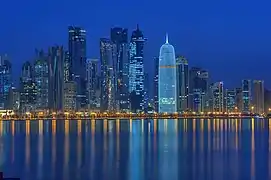
Since 2014, Qatar has been divided into eight municipalities (Arabic: baladiyah).[183]
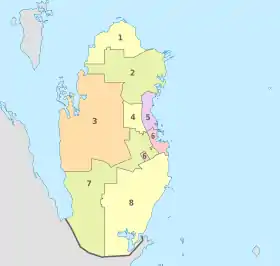
| Key | Municipality (Baladiyah) | بلدية | Population (2015)[184] | Area (km2) | Area (mi2) |
|---|---|---|---|---|---|
| 1 | Al Shamal | الشمال | 8,794 | 859.8 | 331.9 |
| 2 | Al Khor | الخور | 202,031 | 1,613.3 | 622.8 |
| 3 | Al-Shahaniya | الشحانية | 187,571 | 3,309.0 | 1,277.6 |
| 4 | Umm Salal | أم صلال | 90,835 | 318.4 | 122.9 |
| 5 | Al Daayen | الضعاين | 54,339 | 290.2 | 112.0 |
| 6 | Ad Dawhah (Doha) | الدوحة | 956,457 | 202.7 | 78.3 |
| 7 | Al Rayyan | الريان | 605,712 | 2,450 | 946.0 |
| 8 | Al Wakrah | الوكرة | 299,037 | 2,577.7 | 995.2 |
| Dawlat Qatar | دولة قطر | 2,404,776 | 11,621.1 | 4,486.7 |
For statistical purposes, the municipalities are further subdivided into 98 zones (as of 2015),[184] which are in turn subdivided into blocks.[185]
Geography
The Qatari peninsula protrudes 160 kilometres (100 mi) into the Persian Gulf, north of Saudi Arabia. It lies between latitudes 24° and 27° N, and longitudes 50° and 52° E. Most of the country consists of a low, barren plain, covered with sand. To the southeast lies the Khor al Adaid ("Inland Sea"), an area of rolling sand dunes surrounding an inlet of the Persian Gulf. There are mild winters and very hot, humid summers.
The highest point in Qatar is Qurayn Abu al Bawl at 103 metres (338 ft)[2] in the Jebel Dukhan to the west, a range of low limestone outcroppings running north–south from Zikrit through Umm Bab to the southern border. The Jebel Dukhan area also contains Qatar's main onshore oil deposits, while the natural gas fields lie offshore, to the northwest of the peninsula.
Biodiversity
Qatar signed the Rio Convention on Biological Diversity on 11 June 1992, and became a party to the convention on 21 August 1996.[188] It has subsequently produced a National Biodiversity Strategy and Action Plan, which was received by the convention on 18 May 2005.[189] A total of 142 fungal species have been recorded from Qatar.[190] A book recently produced by the Ministry of Environment documents the lizards known or believed to occur in Qatar, based on surveys conducted by an international team of scientists and other collaborators.[191]
Climate
| Climate data for Qatar | |||||||||||||
|---|---|---|---|---|---|---|---|---|---|---|---|---|---|
| Month | Jan | Feb | Mar | Apr | May | Jun | Jul | Aug | Sep | Oct | Nov | Dec | Year |
| Average high °C (°F) | 22 (72) |
23 (73) |
27 (81) |
33 (91) |
39 (102) |
42 (108) |
42 (108) |
42 (108) |
39 (102) |
35 (95) |
30 (86) |
25 (77) |
33 (92) |
| Average low °C (°F) | 14 (57) |
15 (59) |
17 (63) |
21 (70) |
27 (81) |
29 (84) |
31 (88) |
31 (88) |
29 (84) |
25 (77) |
21 (70) |
16 (61) |
23 (74) |
| Average precipitation mm (inches) | 12.7 (0.50) |
17.8 (0.70) |
15.2 (0.60) |
7.6 (0.30) |
2.5 (0.10) |
0 (0) |
0 (0) |
0 (0) |
0 (0) |
0 (0) |
2.5 (0.10) |
12.7 (0.50) |
71 (2.8) |
| Source: http://us.worldweatheronline.com/doha-weather-averages/ad-dawhah/qa.aspx | |||||||||||||
| Sea Climate Data For Doha | |||||||||||||
|---|---|---|---|---|---|---|---|---|---|---|---|---|---|
| Month | Jan | Feb | Mar | Apr | May | Jun | Jul | Aug | Sep | Oct | Nov | Dec | Year |
| Average sea temperature °C (°F) | 21.0 (69.8) |
19.4 (66.9) |
20.9 (69.6) |
23.3 (73.9) |
27.8 (82) |
30.5 (86.9) |
32.4 (90.3) |
33.6 (92.5) |
32.8 (91) |
30.8 (87.4) |
27.5 (81.5) |
23.5 (74.3) |
26.9 (80.5) |
| Source:[192] | |||||||||||||
Economy
.jpg.webp)
Before the discovery of oil, the economy of the Qatari region focused on fishing and pearl hunting. A report prepared by local governors of Ottoman Empire in 1892 states that total income from pearl hunting in 1892 is 2,450,000 kran.[71] After the introduction of the Japanese cultured pearl onto the world market in the 1920s and 1930s, Qatar's pearling industry crashed. Oil was discovered in Qatar in 1940, in Dukhan Field.[193] The discovery transformed the state's economy. Now, the country has a high standard of living for its legal citizens. With no income tax, Qatar (along with Bahrain) is one of the countries with the lowest tax rates in the world. The unemployment rate in June 2013 was 0.1%.[194] Corporate law mandates that Qatari nationals must hold 51% of any venture in the emirate.[89] Trade and industry in the emirate is overseen by the Ministry of Business and Trade.[195]
As of 2016, Qatar has the fourth highest GDP per capita in the world, according to the International Monetary Fund.[196] It relies heavily on foreign labor to grow its economy, to the extent that migrant workers compose 86% of the population and 94% of the workforce.[197][198] Qatar has been criticized by the International Trade Union Confederation.[199] The economic growth of Qatar has been almost exclusively based on its petroleum and natural gas industries, which began in 1940.[200] Qatar is the leading exporter of liquefied natural gas.[161] In 2012, it was estimated that Qatar would invest over $120 billion in the energy sector in the next 10 years.[201] The country was a member state of Organization of Petroleum Exporting Countries (OPEC), having joined in 1961, and having left in January 2019.[202]

In 2012, Qatar retained its title of richest country in the world (according to per capita income) for the third time in a row, having first overtaken Luxembourg in 2010. According to the study published by the Washington-based Institute of International Finance, Qatar's per capita GDP at purchasing power parity (PPP) was $106,000 (QR387,000) in 2012, helping the country retain its ranking as the world's wealthiest nation. Luxembourg came a distant second with nearly $80,000 and Singapore third with per capita income of about $61,000. The research put Qatar's GDP at $182bn in 2012 and said it had climbed to an all-time high due to soaring gas exports and high oil prices. Its population stood at 1.8 million in 2012. The same study published that Qatar Investment Authority (QIA), with assets of $115bn, was ranked 12th among the richest sovereign wealth funds in the world.[203]
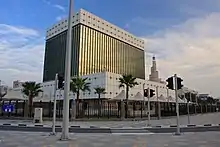
Established in 2005, Qatar Investment Authority is the country's sovereign wealth fund, specializing in foreign investment.[204] Due to billions of dollars in surpluses from the oil and gas industry, the Qatari government has directed investments into United States, Europe, and Asia Pacific. As of 2013, the holdings were valued at $100 billion in assets. Qatar Holding is the international investment arm of QIA. Since 2009, Qatar Holding has received $30–40bn a year from the state. As of 2014, it has investments around the world in Valentino, Siemens, Printemps, Harrods, The Shard, Barclays Bank, Heathrow Airport, Paris Saint-Germain F.C., Volkswagen Group, Royal Dutch Shell, Bank of America, Tiffany, Agricultural Bank of China, Sainsbury's, BlackBerry,[205] and Santander Brasil.[206][207]
The country has no taxes on non-companies,[208] but authorities have announced plans to levy taxes on junk food and luxury items. The taxes would be implemented on goods that harm the human body – for example, fast food, tobacco products, and soft drinks. The rollout of these initial taxes is believed to be due to the fall in oil prices and a deficit that the country faced in 2016. Additionally, the country saw job cuts in 2016 from its petroleum companies and other sectors in the government.[209][210]
Tourism
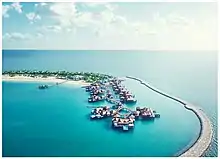
Qatar is one of the fastest growing countries in the field of tourism. According to the World Tourism rankings, more than 2.3 million international tourists visited Qatar in 2017. Qatar has become one of the most open countries in the Middle East due to its recent visa facilitation improvements, including allowing nationals of 88 countries to enter visa-free and free-of charge.[211]
Energy
As of 2012, Qatar has proven oil reserves of 15 billion barrels and gas fields that account for more than 13% of the global resource. As a result, it is the richest state per-capita in the world. None of its 2 million residents live below the poverty line and less than 1% are unemployed.[212]
Qatar's economy was in a downturn from 1982 to 1989. OPEC quotas on crude oil production, the lower price for oil, and the generally unpromising outlook on international markets reduced oil earnings. In turn, the Qatari government's spending plans had to be cut to match lower income. The resulting recessionary local business climate caused many firms to lay off expatriate staff. With the economy recovering in the 1990s, expatriate populations, particularly from Egypt and South Asia, have grown again.
Oil production will not remain at the peak level of 500,000 barrels (80,000 m3) per day for long as the national oil fields are projected to be largely depleted by 2023. Large natural gas reserves have, however, been located off Qatar's northeast coast. Qatar's proved reserves of gas are the third-largest in the world, exceeding 250 trillion cubic feet (7,000 km3). The economy was boosted in 1991 by completion of the $1.5-billion Phase I of North Field gas development. In 1996, the Qatargas project began exporting liquefied natural gas (LNG) to Japan. Further phases of North Field gas development costing billions of dollars are in various stages of planning and development.
.svg.png.webp)
Qatar's heavy industrial projects, all based in Umm Said, include a refinery with a 50,000 barrels (8,000 m3) per day capacity, a fertiliser plant for urea and ammonia, a steel plant, and a petrochemical plant. All these industries use gas for fuel. Most are joint ventures between European and Japanese firms and the state-owned QatarEnergy. The US is the major equipment supplier for Qatar's oil and gas industry, and US companies are playing a major role in North Field gas development.[212]
According to the Emissions Database for Global Atmospheric Research, carbon dioxide emissions per person average over 30 tonnes, one of the highest in the world.[213]
In 2008 Qatar launched its National Vision 2030 which highlights environmental development as one of the four main goals for Qatar over the next two decades. The National Vision pledges to develop sustainable alternatives to oil-based energy to preserve the local and global environment.[214]
Qatar's National Vision 2030 has made investment in renewable resources a major goal for the country over the next two decades.[214] Qatar pursues a vigorous programme of "Qatarisation", under which all joint venture industries and government departments strive to move Qatari nationals into positions of greater authority. Growing numbers of foreign-educated Qataris, including many educated in the US, are returning home to assume key positions formerly occupied by expatriates. To control the influx of expatriate workers, Qatar has tightened the administration of its foreign manpower programmes over the past several years. Security is the principal basis for Qatar's strict entry and immigration rules and regulations.[212]
Transport

With a fast-expanding population and substantial economic growth over the past decade, a reliable and extensive transportation network is becoming increasingly necessary within Qatar. So far the government, the primary transport developer, has done well in terms of keeping up with the demand for new transportation options. In 2008 the Public Works Authority (Ashghal), one of the bodies that oversees infrastructure development, underwent a major reorganisation in order to streamline and modernise the authority in preparation for major project expansions across all segments in the near future. Ashghal works in tandem with the Urban Planning and Development Authority (UPDA), the body that designed the transportation master plan, instituted in March 2006 and running to 2025.
As driving is the primary mode of transport in Qatar, the road network is a major focus of the plan. Project highlights in this segment include the multibillion-dollar Doha Expressway and the Qatar Bahrain Causeway, which would connect Qatar to Bahrain and Saudi Arabia.
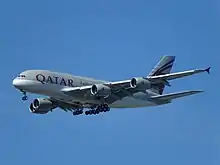
Mass-transit options, such as a Doha metro, light-rail system and more extensive bus networks, are also under development to ease road congestion. In addition, the railway system is being significantly expanded and could eventually form an integral part of a GCC-wide network linking all the Arab states of the Persian Gulf. The airport, too, is expanding capacity to keep up with rising visitor numbers.
Hamad International Airport is the international airport of Doha. In 2014, it replaced the former Doha International Airport as Qatar's principal airport. In 2016, the airport was named the 50th busiest airport in the world by passenger traffic, serving 37,283,987 passengers, a 20.2% increase from 2015.

Qatar is increasingly activating its logistics and ports in order to participate in trade between Europe and China or Africa. For this purpose, ports such as Hamad Port are rapidly expanded and investments are made in their technology. The country is historically and currently part of the Maritime Silk Road that runs from the Chinese coast to the south via the southern tip of India to Mombasa, from there through the Red Sea via the Suez Canal to the Mediterranean, there to the Upper Adriatic region to the northern Italian hub of Trieste with its rail connections to Central Europe, Eastern Europe and the North Sea.[215][216][217] Hamad Port is Qatar's main seaport, located south of Doha in the Umm Al Houl area. Construction of the port began in 2010; it became operational in December 2016. It was officially opened in September 2017, and is expected to become fully operational by 2020.[218] Capable of handling up to 7.8 million tonnes of products annually, the bulk of trade which passes through the port consists of food and building materials.[219] On the northern coast, Ras Laffan Port serves as the most extensive LNG exporting facility in the world.[220]
Qatar Airways is one of the largest airlines in the world that serves in six continents connecting more than 160 destinations every day. Besides, it has won Airline of the Year in 2011, 2012, 2015, 2017 and 2019 due to its outstanding performance and employs more than 46,000 professionals.[221][222]
Demographics
| Year | Pop. | ±% |
|---|---|---|
| 1950 | 25,000 | — |
| 1960 | 47,000 | +88.0% |
| 1970 | 110,000 | +134.0% |
| 1980 | 224,000 | +103.6% |
| 1990 | 476,000 | +112.5% |
| 2000 | 592,000 | +24.4% |
| 2010 | 1,856,000 | +213.5% |
| 2019 | 2,832,000 | +52.6% |
| source:[223][224] | ||
The number of people in Qatar fluctuates considerably depending on the season, since the country relies heavily on migrant labour. In early 2017, Qatar's total population was 2.6 million, with foreigners making up a vast majority of Qatar's population. Only 313,000 of the population (12%) were Qatari citizens, while the remaining 2.3 million (88%) were expatriates.[15]
The combined number of South Asians (from the countries of the Indian subcontinent including Sri Lanka) by themselves represent over 1.5 million people (60%) of Qatar's population. Among these, Indians are the largest community, numbering 650,000 in 2017,[15] followed by 350,000 Nepalis, 280,000 Bangladeshis, 145,000 Sri Lankans, and 125,000 Pakistanis. The contingent of expatriates which are not of South Asian origin represent around 28% of Qatar's population, of which the largest group is 260,000 Filipinos and 200,000 Egyptians, plus many other nationalities (including nationals of other Arab countries, Europeans, etc.).[15]
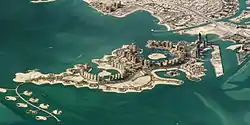
Qatar's first demographic records date back to 1892, and were conducted by Ottoman governors in the region. Based on this census, which includes only the residents in cities, the total population in 1892 was 9,830.[71] The 2010 census recorded the total population at 1,699,435.[5] In January 2013, the Qatar Statistics Authority estimated the country's population at 1,903,447, of which 1,405,164 were males and 498,283 females.[225] At the time of the first census, held in 1970, the population was 111,133.[226] The population has tripled in the decade to 2011, up from just over 600,000 people in 2001, leaving Qatari nationals as less than 15% of the total population.[227] The influx of male labourers has skewed the gender balance, and women are now just one-quarter of the population.
Projections released by the Qatar Statistical Authority indicate that the total population of Qatar could reach 2.8 million by 2020. Qatar's National Development Strategy (2011–16) had estimated that the country's population would reach 1.78m in 2013, 1.81m in 2014, 1.84m in 2015 and 1.86m in 2016 – the yearly growth rate being merely 2.1%. But the country's population has soared to 1.83 million by the end of 2012, showing 7.5% growth over the previous year.[228] Qatar's total population hit a record high of 2.46 million in November 2015, an increase of 8.5% from the previous year, far exceeding official projections.[229]
Religion
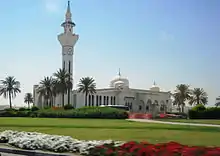
Islam is Qatar's predominant religion and is the state religion although not the only religion practiced in the country.[230] Most Qatari citizens belong to the Salafi Muslim movement of Wahhabism,[231][232][233] and 5–15% of Muslims in Qatar follow Shia Islam with other Islamic sects being very small in number.[234] In 2010, Qatar's population was 67.7% Muslim, 13.8% Christian, 13.8% Hindu, and 3.1% Buddhist; other religions and religiously unaffiliated people accounted for the remaining 1.6%.[235] Sharia law is the main source of Qatari legislation according to Qatar's Constitution.[119][120]
The vision of the Ministry of Awqaf and Islamic Affairs (Qatar) is "to build a contemporary Islamic society along with fostering the Sharee’ah and cultural heritage".
The non-Muslim population is composed almost entirely of foreigners. Since 2008, Christians have been allowed to build churches on ground donated by the government,[237] though foreign missionary activity is officially discouraged.[238] Active churches include the Mar Thoma Church, Malankara Orthodox Syrian Church, the Roman Catholic Church of Our Lady of the Rosary and the Anglican Church of the Epiphany.[239][240][241] There are also two Mormon wards.[239][240][241]
Languages
Arabic is the official language of Qatar, with Qatari Arabic the local dialect. Qatari Sign Language is the language of the deaf community. English is commonly used as a second language,[242] and a rising lingua franca, especially in commerce, to the extent that steps are being taken to try to preserve Arabic from English's encroachment.[243] English is particularly useful for communication with Qatar's large expatriate community. In the medical community, and in situations such as the training of nurses to work in Qatar, English acts as a lingua franca.[244] Reflecting the multicultural make-up of the country, many other languages are also spoken, including Persian, Baluchi, Brahui, Hindi, Malayalam, Urdu, Pashto, Kannada, Tamil, Telugu, Nepali, Sinhalese, Bengali, Tagalog, Tulu and Indonesian.[245]
In 2012, Qatar joined the international French-speaking organisation of La Francophonie (OIF) as a new associate member, but in December 2013, the French daily Le Monde revealed that Qatar, which has very few native French speakers, had not yet paid any contribution to the OIF,[246] while the outgoing Administrator of the OIF complained in 2015 that Qatar had not kept any of the promises it made when it joined the organisation and had never paid its annual membership fees.[247]
Healthcare
Healthcare standards in Qatar are generally high. Qatari citizens are covered by a national health insurance scheme, while expatriates must either receive health insurance from their employers, or in the case of the self-employed, purchase insurance.[248] Qatar's healthcare spending is among the highest in the Middle East, with $4.7 billion being invested in healthcare in 2014.[249] This was a $2.1 billion increase from 2010.[250] The premier healthcare provider in the country is the Hamad Medical Corporation, established by the government as a non-profit healthcare provider, which runs a network of hospitals, an ambulance services, and a home healthcare service, all of which are accredited by the Joint Commission.
In 2010, spending on healthcare accounted for 2.2% of the country's GDP; the highest in the Middle East.[251] In 2006, there were 23.12 physicians and 61.81 nurses per 10,000 inhabitants.[252] The life expectancy at birth was 82.08 years in 2014, or 83.27 years for males and 77.95 years for females, rendering it the highest life expectancy in the Middle East.[253] Qatar has a low infant mortality rate of 7 in 100,000.[254]
In 2006, there were a total of 25 beds per 10,000 people, and 27.6 doctors and 73.8 nurses per 10,000 people.[255] In 2011, the number of beds decreased to 12 per 10,000 people, whereas the number of doctors increased to 28 per 10,000 people. While the country has one of the lowest proportions of hospital beds in the region, the availability of physicians is the highest in the GCC.[256]
Culture
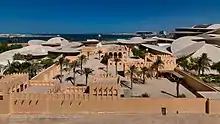
Qatar's culture is similar to other countries in Eastern Arabia, being significantly influenced by Islam. Qatar National Day, hosted annually on 18 December, has had an important role in developing a sense of national identity.[257] It is observed in remembrance of Jassim bin Mohammed Al Thani's succession to the throne and his subsequent unification of the country's various tribes.[258][259] Since 1 July 2008, Hamad Bin Abdulaziz Al-Kawari has been the Minister for Culture, Arts and Heritage of Qatar.
Doha Cultural Festival
The Doha Cultural Festival is one of the cultural activities carried out annually by the Qatari Ministry of Culture, Arts and Heritage, which began in 2002 with the aim of spreading Qatari culture inside and outside Qatar.
Arts and museums
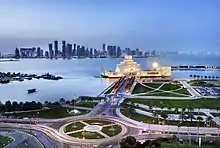
Several senior members of Qatar's ruling Al Thani family are noted collectors of Islamic and contemporary art.
The Museum of Islamic Art, opened in 2008, is regarded as one of the best museums in the region.[260] This, and several other Qatari museums, like the Arab Museum of Modern Art, falls under the Qatar Museums Authority (QMA) which is led by Sheikha Al-Mayassa bint Hamad bin Khalifa Al-Thani, the sister of the ruling Emir of the State of Qatar, and the prominent collector and art patron Sheikh Hassan bin Mohammed Al Thani.[261] The QMA also sponsors artistic events abroad, such as major exhibitions by Takahashi Murakami in Versailles (2010) and Damien Hirst in London (2012).
Qatar is the world's biggest buyer in the art market by value.[262] The Qatari cultural sector is being developed to enable the country to reach world recognition to contribute to the development of a country that comes mainly from its resources from the gas industry.[263]
The National Museum of Qatar was opened to the public on 28 March 2019.[264]
Literature
Qatari literature traces its origins back to the 19th century. Originally, written poetry was the most common form of expression. Abdul Jalil Al-Tabatabai and Mohammed bin Abdullah bin Uthaymeen, two poets dating back to the early 19th century, formed the corpus of Qatar's earliest written poetry. Poetry later fell out of favor after Qatar began reaping the profits from oil exports in the mid-20th century and many Qataris abandoned their Bedouin traditions in favor of more urban lifestyles.[265]
Due to the increasing number of Qataris who began receiving formal education during the 1950s and other significant societal changes, 1970 witnessed the introduction of the first short story anthology, and in 1993 the first locally authored novels were published. Poetry, particularly the predominant nabati form, retained some importance but would soon be overshadowed by other literary types.[265] Unlike most other forms of art in Qatari society, females have been involved in the modern literature movement on a similar magnitude to males.[266]
Media

Qatar's media was classified as "not free" in the 2014 Freedom of the Press report by Freedom House.[267] TV broadcasting in Qatar was started in 1970.[268] Al Jazeera is a main television network headquartered in Doha, Qatar. Al Jazeera initially launched in 1996 as an Arabic news and current affairs satellite TV channel of the same name, but has since expanded into a global network of several speciality TV channels known collectively as the Al Jazeera Media Network.
It has been reported that journalists practice self-censorship, particularly in regards to the government and ruling family of Qatar.[269] Criticism of the government, Emir and ruling family in the media is illegal. According to article 46 of the press law "The Emir of the state of Qatar shall not be criticised and no statement can be attributed to him unless under a written permission from the manager of his office."[270] Journalists are also subject to prosecution for insulting Islam.[267]
In 2014, a Cybercrime Prevention Law was passed. The law is said to restrict press freedom and carries prison sentences and fines for broad reasons such as jeopardising local peace or publishing false news.[271] The Gulf Center for Human Rights has stated that the law is a threat to freedom of speech and has called for certain articles of the law to be revoked.[272]
Press media has undergone expansion in recent years. There are currently seven newspapers in circulation in Qatar, with four being published in Arabic and three being published in English.[273] There are also newspapers from India, Nepal and Sri Lanka with editions printed from Qatar.
In regards to telecommunication infrastructure, Qatar is the highest-ranked Middle Eastern country in the World Economic Forum's Network Readiness Index (NRI) – an indicator for determining the development level of a country's information and communication technologies. Qatar ranked number 23 overall in the 2014 NRI ranking, unchanged from 2013.[274]
Music
The music of Qatar is based on Bedouin poetry, song and dance. Traditional dances in Doha are performed on Friday afternoons; one such dance is the Ardah, a stylised martial dance performed by two rows of dancers who are accompanied by an array of percussion instruments, including al-ras (a large drum whose leather is heated by an open fire), tambourines and cymbals with small drums.[275] Other percussion instruments used in folk music include galahs (a tall clay jar) and tin drinking cups known as tus or tasat, usually used in conjunction with a tabl, a longitudinal drum beaten with a stick.[276] String instruments, such as the oud and rebaba, are also commonly used.[275]
Sport
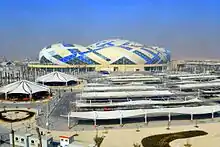
Association football is the most popular sport in Qatar, both in terms of players and spectators.[277] Shortly after the Qatar Football Association became affiliated with FIFA in 1970, one of the country's earliest international accolades came in 1981 when the Qatar national under-20 team's emerged as runners-up to West Germany in that year's edition of the FIFA World Youth Championship after being defeated 4–0 in the final. At the senior level, Qatar has played host to two editions of the AFC Asian Cup; the first coming being the 9th edition in 1988 and the second being the 15th edition held in 2011.[278] For the first time in the country's history, the Qatar national football team won the AFC Asian Cup in the 2019 edition hosted in the UAE, beating Japan 3–1 in the final. They won all seven of their matches, conceding only a single goal throughout the tournament.[279]
.jpg.webp)
On 2 December 2010, Qatar won their bid to host the 2022 FIFA World Cup, despite never previously qualifying for the FIFA World Cup Finals.[280] Local organisers built 7 new stadiums and expanded 1 existing stadium for this event.[281][282] Qatar's winning bid for the 2022 World Cup was greeted enthusiastically in the Persian Gulf region as it was the first time a country in the Middle East had been selected to host the tournament. However, the bid has been embroiled in much controversy, including allegations of bribery and interference in the investigation of the alleged bribery. European football associations have also objected to the 2022 World Cup being held in Qatar for a variety of reasons, from the impact of warm temperatures on players' fitness, to the disruption it might cause in European domestic league calendars should the event be rescheduled to take place during winter.[283][284] In May 2014, Qatari football official Mohammed bin Hammam was accused of making payments totalling £3m to officials in return for their support for the Qatar bid.[285] However, a FIFA inquiry into the bidding process in November 2014 cleared Qatar of any wrongdoing.[286]
The Guardian, a British national daily newspaper, produced a short documentary named "Abuse and exploitation of migrant workers preparing emirate for 2022".[287] A 2014 investigation by The Guardian reports that migrant workers who have been constructing luxurious offices for the organisers of the 2022 World Cup have not been paid in over a year, and are now "working illegally from cockroach-infested lodgings."[288] For 2014, Nepalese migrants involved in constructing infrastructure for the 2022 World Cup died at a rate of one every two days.[289] The Qatar 2022 organising committee have responded to various allegations by claiming that hosting the World Cup in Qatar would act as a "catalyst for change" in the region.[290] According to a February 2021 article in The Guardian, some 6,500 migrant construction workers have died.[291]
Qatar was estimated to host a football fanbase of 1.6 million for the 2022 FIFA World Cup 2022. However, the construction work in country was expected to only take the available 37,000 hotel rooms to 70,000 by the end of 2021. In December 2019, the Qatari World Cup officials approached the organizers of the Glastonbury Festival in England and the Coachella Festival in the US, to plan huge desert campsites for thousands of football fans. The World Cup campsites on the outskirts were reported to have licensed bars, restaurants, entertainment and washing facilities. Moreover, two cruise ships were also reserved as temporary floating accommodations for nearly 40,000 people during the tournament.[292]
Though football is the most popular sport, other team sports have experienced considerable success at senior level. In 2015, the national handball team emerged as runners-up to France in the World Men's Handball Championship as hosts, however the tournament was marred by numerous controversies regarding the host nation and its team.[293] Further, in 2014, Qatar won the world championship in men's 3x3 basketball.[294]
Khalifa International Tennis and Squash Complex in Doha hosted the WTA Tour Championships in women's tennis between 2008 and 2010. Doha holds the WTA Premier tournament Qatar Ladies Open annually. Since 2002, Qatar has hosted the annual Tour of Qatar, a cycling race in six stages. Every February, riders are racing on the roads across Qatar's flat land for six days. Each stage covers a distance of more than 100 km, though the time trial usually is a shorter distance. Tour of Qatar is organised by the Qatar Cycling Federation for professional riders in the category of Elite Men.[295]
The Qatar Army Skydiving Team has several different skydiving disciplines placing among the top nations in the world. The Qatar National Parachute team performs annually during Qatar's National Day and at other large events, such as the 2015 World Handball Championship.[296] Doha four times was the host of the official FIVB Volleyball Men's Club World Championship and three times host FIVB Volleyball Women's Club World Championship. Doha one time Host Asian Volleyball Championship.[297]
On 3 September 2020, the Education City Stadium hosted its first-ever official match, where the local clubs Al Sadd SC and Al Kharaitiyat SC contested the season-opener of the 2020–21 Qatar Stars League.[298]
Education
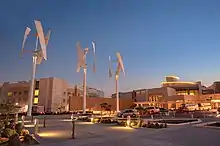
Qatar hired the RAND Corporation to reform its K–12 education system.[161] Through Qatar Foundation, the country has built Education City, a campus which hosts local branches of the Weill Cornell Medical College, Carnegie Mellon School of Computer Science, Georgetown University School of Foreign Service, Northwestern's Medill School of Journalism, Texas A&M's School of Engineering, Virginia Commonwealth University School of the Arts and other Western institutions.[161][299]
The illiteracy rate in Qatar was 3.1% for males and 4.2% for females in 2012, the lowest in the Arab-speaking world, but 86th in the world.[300] Citizens are required to attend government-provided education from kindergarten through high school.[301] Qatar University, founded in 1973, is the country's oldest and largest institution of higher education.[302][303]
In November 2002, emir Hamad bin Khalifa Al Thani created The Supreme Education Council.[304] The Council directs and controls education for all ages from the pre-school level through the university level, including the "Education for a New Era" initiative which was established to try to position Qatar as a leader in education reform.[305][306] According to the Webometrics Ranking of World Universities, the top-ranking universities in the country are Qatar University (1,881st worldwide), Texas A&M University at Qatar (3,905th) and Weill Cornell Medical College in Qatar (6,855th).[307]
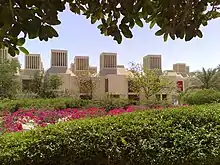
In 2009, Qatar established the Qatar Science & Technology Park in Education City to link those universities with industry. Education City is also home to a fully accredited international Baccalaureate school, Qatar Academy. In addition, two Canadian institutions, the College of the North Atlantic (headquarters in Newfoundland and Labrador) and the University of Calgary, have inaugurated campuses in Doha. Other for-profit universities have also established campuses in the city.[308]
In 2012, Qatar was ranked third from the bottom of the 65 OECD countries participating in the PISA test of maths, reading and skills for 15- and 16-year-olds, comparable to Colombia or Albania, despite having the highest per capita income in the world.[309][310] Qatar was ranked 48th in the Global Innovation Index in 2021, down from 65th in 2019.[311][312][313][314]
As part of its national development strategy, Qatar has outlined a 10-year strategic plan to improve the level of education.[315] The government has launched educational outreach programs, such as Al-Bairaq. Al-Bairaq was launched in 2010 aims to provide high school students with an opportunity to experience a research environment in the Center for Advanced Materials in Qatar University. The program encompasses the STEM fields and languages.[316]
Science and technology
Launched in 2006 as part of an initiative of the quasi-governmental Qatar Foundation, the Qatar National Research Fund was created with the intent of securing public funds for scientific research within the country. The fund functions as a means for Qatar to diversify its economy from a primarily oil and gas-based one to a knowledge-based economy.[317]
The Qatar Science & Technology Park (QSTP) was established by Qatar Foundation in March 2009 as an attempt to assist the country's transition towards a knowledge economy.[318][319] With a seed capital of $800 million and initially hosting 21 organizations,[319] the QSTP became Qatar's first free-trade zone.[320]
See also
- List of Qatar-related topics
- Outline of Qatar
- 2022 FIFA World Cup
References
- (Arabic: دولة قطر, romanized: Dawlat Qaṭar)
- "The Constitution" (PDF). Government Communications Office. Government Communications Office. Retrieved 31 August 2020.
- "Qatar". CIA World Factbook. Central Intelligence Agency. 8 February 2012. Retrieved 4 March 2012.
- "Population By Religion, Gender And Municipality March 2020". Qatar Statistics Authority.
- "Population structure". Ministry of Development Planning and Statistics. 31 January 2020.
- "Populations". Qsa.gov.qa. Archived from the original on 9 July 2010. Retrieved 2 October 2010.
- "World Economic Outlook Database, April 2018 – Report for Selected Countries and Subjects". International Monetary Fund (IMF). April 2018. Archived from the original on 4 May 2018.
- "GINI index". World Bank. Retrieved 22 January 2013.
- "Human Development Report 2021/2022" (PDF). United Nations Development Programme. 8 September 2022. Retrieved 8 September 2022.
- "List of left- & right-driving countries – World Standards". Retrieved 5 June 2017.
- Pronunciation adopted by Qatar Airways' advertisements, such as Qatar Airways: the Art of Flight Redefined
- "CMU Pronouncing Dictionary". CS. Retrieved 28 March 2010.
- Johnstone, T. M. (2008). "Encyclopaedia of Islam". Ķaṭar. Brill Online. Retrieved 22 January 2013. (subscription required)
- "How do you say 'Qatar'? Senate hearing has the answer". Washington Post. 12 June 2014. Retrieved 12 March 2015.
- "Qatar: Freedom in the World 2020 Country Report". Freedom House. Retrieved 6 April 2021.
- "Population of Qatar by nationality – 2017 report". Retrieved 7 February 2017.
- "The Constitution". Archived from the original on 24 October 2004. Retrieved 29 October 2017.
- "GDP per capita, PPP (current international $) | Data". data.worldbank.org. Retrieved 28 July 2020.
- "GNI per capita, Atlas method (current US$) | Data". data.worldbank.org. Retrieved 28 July 2020.
- "2019 Human Development Index Ranking | Human Development Reports". hdr.undp.org. Archived from the original on 30 April 2020. Retrieved 28 July 2020.
- "Indices & Data | Human Development Reports". United Nations Development Programme. 14 March 2013. Archived from the original on 12 January 2013. Retrieved 27 June 2013.
- "2022 World LNG Report Press Release" (PDF). International Gas Union (IGU). 6 July 2022. Retrieved 7 October 2022.
- "Where in the world do people emit the most CO2?". Our World in Data. Retrieved 17 July 2021.
- Cooper, Andrew F. "Middle Powers: Squeezed out or Adaptive?". Public Diplomacy Magazine. Archived from the original on 17 March 2015. Retrieved 12 March 2015.
- Kamrava, Mehran. "Mediation and Qatari Foreign Policy" (PDF). Archived from the original (PDF) on 7 October 2013. Retrieved 12 March 2015.
- Dagher, Sam (17 October 2011). "Tiny Kingdom's Huge Role in Libya Draws Concern". Online.wsj.com. Retrieved 30 December 2013.
- "Qatar: Rise of an Underdog". Politicsandpolicy.org. Archived from the original on 10 June 2017. Retrieved 30 December 2013.
- Black, Ian (26 October 2011). "Qatar admits sending hundreds of troops to support Libya rebels". The Guardian. Retrieved 30 December 2013.
- "Qatar". Amnesty International. Retrieved 19 June 2022.
- "Qatar". Human Rights Watch. 13 January 2022. Retrieved 19 June 2022.
- "Amir: 2022 World Cup Qatar a tournament for all Arabs". Gulf Times. 15 July 2018. Retrieved 7 September 2018.
- "Doha to host 2030 Asian Games as Riyadh gets 2034 edition". sportspromedia.com. 17 December 2020. Retrieved 4 February 2021.
- Casey, Paula; Vine, Peter (1992). The heritage of Qatar. Immel Publishing. p. 17. ISBN 9780907151500.
- "History of Qatar". Qatar Statistics Authority. Archived from the original on 6 June 2017. Retrieved 11 May 2015.
- "Maps". Qatar National Library. Archived from the original on 6 June 2017. Retrieved 11 May 2015.
- "About us". Katara. Archived from the original on 22 July 2015. Retrieved 11 May 2015.
- Hazlitt, William (1851). The Classical Gazetteer: A Dictionary of Ancient Geography, Sacred and Profane. Whittaker & co.
- Rahman, Habibur (2010). The Emergence of Qatar: The Turbulent Years 1627–1916. London: Routledge. p. 1. ISBN 9780710312136.
- Toth, Anthony. "Qatar: Historical Background." A Country Study: Qatar (Helen Chapin Metz, editor). Library of Congress Federal Research Division (January 1993). This article incorporates text from this source, which is in the public domain.
- Khalifa, Haya; Rice, Michael (1986). Bahrain Through the Ages: The Archaeology. Routledge. pp. 79, 215. ISBN 978-0710301123.
- "History of Qatar" (PDF). www.qatarembassy.or.th. Ministry of Foreign Affairs. Qatar. London: Stacey International, 2000. Retrieved 9 January 2015.
- Rice, Michael (1994). Archaeology of the Persian Gulf. Routledge. pp. 206, 232–233. ISBN 978-0415032681.
- Magee, Peter (2014). The Archaeology of Prehistoric Arabia. Cambridge Press. pp. 50, 178. ISBN 9780521862318.
- Sterman, Baruch (2012). Rarest Blue: The Remarkable Story Of An Ancient Color Lost To History And Rediscovered. Lyons Press. pp. 21–22. ISBN 978-0762782222.
- Cadène, Philippe (2013). Atlas of the Gulf States. BRILL. p. 10. ISBN 978-9004245600.
- "Qatar – Early history". globalsecurity.org. Retrieved 17 January 2015.
- Gillman, Ian; Klimkeit, Hans-Joachim (1999). Christians in Asia Before 1500. University of Michigan Press. pp. 87, 121. ISBN 978-0472110407.
- Commins, David (2012). The Gulf States: A Modern History. I. B. Tauris. p. 16. ISBN 978-1848852785.
- Habibur Rahman, p. 33
- "AUB academics awarded $850,000 grant for project on the Syriac writers of Qatar in the 7th century AD" (PDF). American University of Beirut. 31 May 2011. Archived from the original (PDF) on 28 May 2015. Retrieved 12 May 2015.
- Kozah, Mario; Abu-Husayn, Abdulrahim; Al-Murikhi, Saif Shaheen (2014). The Syriac Writers of Qatar in the Seventh Century. Gorgias Press LLC. p. 24. ISBN 978-1463203559.
- "Bahrain". maritimeheritage.org. Retrieved 17 January 2015.
- Fromherz, Allen (13 April 2012). Qatar: A Modern History. Georgetown University Press. pp. 44, 60, 98. ISBN 978-1-58901-910-2.
- Rahman, Habibur (2006). The Emergence Of Qatar. Routledge. p. 34. ISBN 978-0710312136.
- A political chronology of the Middle East. Routledge / Europa Publications. 2001. p. 192. ISBN 978-1857431155.
- Page, Kogan (2004). Middle East Review 2003–04: The Economic and Business Report. Kogan Page Ltd. p. 169. ISBN 978-0749440664.
- Qatar, 2012 (The Report: Qatar). Oxford Business Group. 2012. p. 233. ISBN 978-1907065682.
- Casey, Paula; Vine, Peter (1992). The heritage of Qatar. Immel Publishing. pp. 184–185. ISBN 9780907151500.
- Russell, Malcolm (2014). The Middle East and South Asia 2014. Rowman & Littlefield Publishers. p. 151. ISBN 978-1475812350.
- "History". qatarembassy.net. Archived from the original on 17 February 2015. Retrieved 18 January 2015.
- Larsen, Curtis (1984). Life and Land Use on the Bahrain Islands: The Geoarchaeology of an Ancient Society (Prehistoric Archeology and Ecology series). University of Chicago Press. p. 54. ISBN 978-0226469065.
- Althani, Mohamed (2013). Jassim the Leader: Founder of Qatar. Profile Books. p. 16. ISBN 978-1781250709.
- Gillespie, Carol Ann (2002). Bahrain (Modern World Nations). Chelsea House Publications. p. 31. ISBN 978-0791067796.
- Anscombe, Frederick (1997). The Ottoman Gulf: The Creation of Kuwait, Saudi Arabia, and Qatar. Columbia University Press. p. 12. ISBN 978-0231108393.
- Potter, Lawrence (2010). The Persian Gulf in History. Palgrave Macmillan. p. 262. ISBN 978-0230612822.
- Heard-Bey, Frauke (2008). From Tribe to State. The Transformation of Political Structure in Five States of the GCC. p. 39. ISBN 978-88-8311-602-5.
- 'Gazetteer of the Persian Gulf. Vol I. Historical. Part IA & IB. J G Lorimer. 1915' [1000] (1155/1782), p. 1001
- Crystal, Jill (1995). Oil and Politics in the Gulf: Rulers and Merchants in Kuwait and Qatar. Cambridge University Press. p. 27. ISBN 978-0521466356.
- Casey, Michael S. (2007). The History of Kuwait (The Greenwood Histories of the Modern Nations). Greenwood. pp. 37–38. ISBN 978-0313340734.
- "'Gazetteer of the Persian Gulf. Vol I. Historical. Part IA & IB. J G Lorimer. 1915' [843] (998/1782)". qdl.qa. Retrieved 13 January 2014.
- "Qatar". Teachmideast.org. Retrieved 27 June 2013.
- Kursun, Zekeriya (2004). Katar'da Osmanlilar 1871–1916. Turk Tarih Kurumu.
- Zahlan, Rosemarie Said (2016). The Creation of Qatar. Routledge. p. 42.
- Wilkinson, John Craven (1991). Arabia's Frontiers: The Story of Britain's Boundary Drawing in the Desert. IB Tauris. pp. 46–47.
- Rahman, Habibur (2005). The Emergence of Qatar: The Turbulent Years 1627-1916. Routledge. p. 235.
- Rogan, Eugene; Murphey, Rhoads; Masalha, Nur; Durac, Vincent; Hinnebusch, Raymond (November 1999). "Review of The Ottoman Gulf: The Creation of Kuwait, Saudi Arabia and Qatar by Frederick F. Anscombe; The Blood-Red Arab Flag: An Investigation into Qasimi Piracy, 1797–1820 by Charles E. Davies; The Politics of Regional Trade in Iraq, Arabia and the Gulf, 1745–1900 by Hala Fattah". British Journal of Middle Eastern Studies. 26 (2): 339–342. doi:10.1080/13530199908705688. JSTOR 195948.
- Habibur Rahman, pgs.143–144
- Habibur Rahman, pgs.150–151
- Habibur Rahman, p. 152
- "Battle of Al Wajbah". Qatar Visitor. 2 June 2007. Archived from the original on 17 January 2013. Retrieved 22 January 2013.
- "Amiri Diwan – Shaikh Abdullah Bin Jassim Al Thani". Diwan.gov.qa. Archived from the original on 10 February 2012. Retrieved 28 October 2012.
- Zahlan, Rosemarie Said (1979). The Creation of Qatar. Abingdon: Croom Helm. p. 74. ISBN 978-1-138-18167-0. Retrieved 27 May 2019.
- Zahlan, Rosemarie Said (1979). The Creation of Qatar. Abingdon: Croom Helm. pp. 73–85. ISBN 978-1-138-18167-0. Retrieved 27 May 2019.
- Morton, Michael Quentin (2017). Empires and Anarchies: A History of Oil in the Middle East. London: Reaktion Books. pp. 139–140. ISBN 978-1-78023-810-4. Retrieved 27 May 2019.
- Wilton, John, unpublished memoir, ‘Qatar and Sharjah, 1949–1952’, Special Collections, University of Exeter Library, Exeter.
- Said Zahlan, Rosemarie (1979). The Creation of Qatar. Abingdon: Croom Helm. p. 144. ISBN 0-06-497965-2.
- Exchange of Notes constituting an Agreement between the United Kingdom of Great Britain and Northern Ireland and Kuwait regarding relations between the United ... Exchange of Notes concerning the Termination of Special Treaty Relations ... Northern Ireland and the State of Qatar, 3 September 1971
- A Treaty of Friendship and an Exchange of Notes, each entered into on 3 September 1971
- "New Qatari emir Sheikh Tamim 'set to announce reshuffle'". BBC News. 26 June 2013. Retrieved 26 June 2013.
- nouvelobs.com: "Qatar : "S'ils pouvaient, ils achèteraient la Tour Eiffel", 7 April 2013
- "140th Assembly and related meetings". Inter-Parliamentary Union. 4 January 2018. Retrieved 31 March 2019.
- "Qatar (01/10)". State.gov. Retrieved 28 March 2010.
- "Last respects paid to teacher killed by bomb". Dorset Echo.
- Coman, Julian (21 March 2005). "Egyptian Suicide Bomber Blamed for Attack in Qatar". The Independent.
- Analytica, Oxford (25 March 2005). "The Advent of Terrorism in Qatar". Forbes.
- "Qatar Timeline". BBC News. 14 June 2012. Retrieved 7 January 2013.
- Roula Khalaf & Abigail Fielding Smith (16 May 2013). "Qatar bankrolls Syrian revolt with cash and arms". Financial Times. Retrieved 3 June 2013.
- Rashid, Ahmed (4 October 2017). "Why closing the Taliban's Qatar office would be an error". Financial Times. Retrieved 30 October 2017.
- Nordland, Rod (24 June 2013). "In Surprise, Emir of Qatar Plans to Abdicate, Handing Power to Son". NYTimes.com. Retrieved 26 June 2013.
- "The World factbook". CIA.Gov. 20 June 2014. Retrieved 20 June 2014.
- "Saudi-led coalition strikes rebels in Yemen, inflaming tensions in region". CNN. 27 March 2015.
- "Saudi Arabia and Bahrain break diplomatic ties with Qatar over 'terrorism'". The Guardian. 5 June 2017. Retrieved 5 June 2017.
- Paul Rhys in Doha. "Blatter reaches out to Arabia". Aljazeera.com. Retrieved 30 December 2013.
- BBC News, How democratic is the Middle East?, 9 September 2005.
- United States Department of State Country Reports on Human Rights Practices for 2011: Qatar, 2011.
- Gardener, David. "Qatar shows how to manage a modern monarchy". Financial Times.
- "Embassy of Canada to the State of Qatar". Government of Canada. Retrieved 4 February 2021.
- "BBC NEWS – Middle East – How democratic is the Middle East?". news.bbc.co.uk. Retrieved 5 June 2017.
- "Documents" (PDF). www.state.gov.
- Lambert, Jennifer (2011). "Political Reform in Qatar: Participation, Legitimacy and Security". Middle East Policy. 19 (1).
- "Qatar to hold advisory council elections in 2013". Reuters (UK edition). Reuters. 1 November 2011. Retrieved 4 March 2012.
- "IFES Election Guide – Elections: Qatar Referendum Apr 29 2003". www.electionguide.org. Retrieved 5 June 2017.
- "Qatar 2003". www.princeton.edu. Archived from the original on 10 October 2017. Retrieved 5 June 2017.
- "Qatari emir Sheikh Hamad hands power to son Tamim". BBC. 25 June 2013. Retrieved 25 June 2013.
- "Council of Ministers". Embassy of the State of Qatar in Washington DC. Archived from the original on 12 June 2010. Retrieved 4 March 2012.
- Thafer, Dania (14 October 2021). "Qatar's first elected parliament may have more power than other Persian Gulf legislatures. Here's why". The Washington Post. Retrieved 2 April 2022.
- "Qatari elections: A PR stunt or a step toward democracy? | DW | 24.08.2021". DW.COM. Retrieved 7 November 2021.
- "Legislative elections in Qatar postponed until at least 2019". Doha News. 17 June 2016. Archived from the original on 29 September 2017. Retrieved 26 May 2017.
- "The People Want Reform… In Qatar, Too". Jadaliyya. Archived from the original on 10 October 2017. Retrieved 9 February 2015.
- "The Permanent Constitution of the State of Qatar". Government of Qatar. Archived from the original on 6 October 2014.
- "Constitution of Qatar".
According to Article 1: Qatar is an independent Arab country. Islam is its religion and Sharia law is the main source of its legislation.
- "The World Factbook". U.S. Central Intelligence Agency. 27 September 2021.
- "Qatar" (PDF). US Department of State.
- "Qatar Gender Equality Profile" (PDF). UNICEF. Archived from the original (PDF) on 29 June 2014. Retrieved 20 February 2013.
- "Qatar". Amnesty International Annual Report 2012. Amnesty International. Archived from the original on 12 March 2014. Retrieved 19 March 2014.
- News, G. M. A. "Filipino woman gets 100 lashes for giving birth in Qatar". GMA News Online.
{{cite web}}:|last=has generic name (help) - "Qatar". Amnesty International Report 2010. Amnesty International. Archived from the original on 8 July 2014.
- "Qatar". Amnesty International Annual Report 2011. Amnesty International. Archived from the original on 7 April 2014.
- "Qatar sentences man to 40 lashes for drinking alcohol". Arabian Business.
- "Qatar sentences man to lashes for drinking alcohol". Al Akhbar. Archived from the original on 6 October 2014. Retrieved 11 August 2014.
- "Qatar court orders lashing of Muslim barber over drinking alcohol". Al Arabiya. 22 April 2013.
- "Indian expat sentenced to 40 lashes in Qatar for drink-driving". Arabian Business.
- "Special report: The punishment was death by stoning. The crime? Having". The Independent. 28 September 2013.
- Jenifer Fenton. "Religious law, prison for "blasphemy", severe sexual inequalilty: Qatar's human rights review".
- "United Explanations – What are the worst countries in the world to be gay?".
- Davies Krish (9 April 2019). "General Laws and Regulations in Qatar". OnlineQatar.
- Alex Delmar-Morgan (7 January 2012). "Qatar, Unveiling Tensions, Suspends Sale of Alcohol". The Wall Street Journal. Retrieved 17 January 2012.
- Jenifer Fenton (16 January 2012). "Qatar's Impromptu Alcohol Ban". The Arabist. Retrieved 17 January 2012.
- "Qatar Distribution Company". Qatar Loving.
- "Purchasing Alcohol in Qatar". Qatar Visitor. 2 June 2007. Archived from the original on 1 May 2011. Retrieved 1 May 2011.
- Walid, Tamara (11 November 2009). "Qatar would 'welcome' Israel in 2022". The National. Retrieved 10 August 2013.
- James M. Dorsey (17 January 2012). "Debate Questions Emir's Powers To Shape Qatar's Positioning As Sports Hub And Sponsor of Revolts – Analysis". The Eurasia Review. Retrieved 17 January 2012.
- "Alcohol ban lifted for new hotel on The Pearl-Qatar". Arabian Business. Retrieved 19 June 2017.
- Elgot, Jessica (28 May 2014). "'Leggings Are Not Pants' Qatar's New Modesty Campaign Aimed At Westerners'". Huffington Post.
- Aningtias Jatmika (29 May 2014). "Qatar Bans Tourists from Wearing Leggings in Public".
- Boghardt, Lori Plotkin (6 October 2014). "Qatar Is a U.S. Ally. They Also Knowingly Abet Terrorism. What's Going On?". New Republic. Retrieved 7 October 2014.
Two overarching goals have driven Qatari policy. One has been to maximize Qatar's influence on the regional and international stage. This originally reflected the personal ambition of the former ruler and current emir's father, Shaykh Hamad bin Khalifa al Thani, and his foreign minister and eventual prime minister, Shaykh Hamad bin Jassim al Thani. The two men directed foreign policy until the father abdicated in favor of his son, Emir Tamim bin Hamad al Thani, in July 2013. The second objective has been to preserve the security of the ruling family and state.
- "Qatar's Regional Relations and Foreign Policy After Al Ula". The Arab Gulf States Institute in Washington. 14 April 2021.
- Kirkpatrick, David D.; Barnard, Anne (7 June 2017). "Terrorist Attacks Pour Gas on Saudi- Iranian Rivalry and Gulf Tensions". Eurasia Diary. Retrieved 11 June 2017.
- "Qatar Opens Its Doors to All, to the Dismay of Some". The New York Times. 16 July 2017.
- H Rahman (2005). The Emergence of Qatar. Routledge. ISBN 978-0-7103-1213-6. Retrieved 26 June 2013.
- "Qatar, China enjoy strong ties based on respect". Gulf-Times (in Arabic). 11 July 2018.
- "Qatar and Saudi Arabia sign defense agreement". Tehrantimes.com. 25 February 2010. Retrieved 2 October 2010.
- "How Qatar and Turkey came together". The Economist. 21 January 2021.
- "Qatar relies on US base amid Gulf tensions". Financial Times. FT.com. 24 September 2010. Retrieved 16 June 2013.
- Mark Mazzetti; C.J. Chivers; Eric Schmitt (30 June 2013). "Taking Outsize Role in Syria, Qatar Funnels Arms to Rebels". New York Times. Retrieved 21 January 2014.
- Jay Solomon (10 October 2014). "U.S.-Qatar Alliance Strains Coalition Against Islamic State". The Wall Street Journal.
- "Six nations cut diplomatic ties to Qatar as Arab rift deepens". Hurriyet Daily News. 5 June 2017.
- "Saudi Arabia, UAE, Egypt and Bahrain break diplomatic ties with Qatar over 'terrorism'". The Guardian. 5 June 2017.
- "Qatar appoints first ambassador to Saudi Arabia Since Rift". Al Jazeera. August 2021.
- "Military expenditure by country as percentage of gross domestic product, 2003–2016" (PDF). SIPRI.
- "The SIPRI Military Expenditure Database". Stockholm International Peace Research Institute. Archived from the original on 28 March 2010. Retrieved 29 October 2011.
- "The Strange Power of Qatar by Hugh Eakin". The New York Review of Books. Retrieved 16 June 2013.
- "Trends in International Arms Transfer, 2014". www.sipri.org. Stockholm International Peace Research Institute. Archived from the original on 19 March 2015. Retrieved 18 March 2015.
- "TIV of arms imports to the top 50 largest importers, 2016-2016". SIPRI.
- "Saudi Arabia uses terrorism as an excuse for human rights abuses". Al Jazeera America. 3 December 2015.
- "Yemen crisis: Who is fighting whom?". 28 March 2017. Retrieved 5 June 2017 – via www.bbc.com.
- "Airstrike Hits Doctors Without Borders Hospital in Yemen". Scientific American. Retrieved 5 June 2017.
- "Yemen conflict: MSF hospital destroyed by air strikes". BBC News. 27 October 2015. Retrieved 5 June 2017.
- Kelly, Tobias (2009). "The UN Committee against Torture: Human Rights Monitoring and the Legal Recognition of Cruelty". Human Rights Quarterly. 313 (3): 777–800. doi:10.1353/hrq.0.0094. hdl:20.500.11820/3b940ee1-e99f-4ab6-bbb1-37face2fae2c. S2CID 145632406.
- Conclusions and Recommendations: Qatar (Report). UN Committee Against Torture. 25 July 2006. U.N. Doc. CAT/C/QAT/CO/1. Retrieved 9 January 2012.
"Certain provisions of the Criminal Code allow punishments such as flogging and stoning to be imposed as criminal sanctions by judicial and administrative authorities. These practices constitute a breach of the obligations imposed by the Convention. The Committee notes with interest that authorities are presently considering amendments to the Prison Act that would abolish flogging." (Par. 12)
- "Death penalties in the world -Qatar". 2014.
- "LGBT relationships are illegal in 74 countries, research finds". The Independent. 17 May 2016.
- "Country Narratives". Human Trafficking Report 2011. Office to Monitor and Combat Trafficking in Persons, United States Department of State. June 2011. Retrieved 21 January 2012.
- "International unions warn Qatar's work visa system allows employers to use forced labour". ITUC-CSI-IGB.
- "Qatar to allow trade union, scrap 'sponsor' system". Al Arabiya. 1 May 2012. Archived from the original on 12 August 2014. Retrieved 12 March 2015.
- Owen Gibson (14 May 2014). "Qatar government admits almost 1,000 fatalities among migrants". TheGuardian.com.
- Wilson, Nigel (21 July 2014). "Qatar Announces New Labour Law Reforms Amid Workers' Rights Outcry". International Business Times. Retrieved 12 March 2015.
- Walker, Lesley (15 January 2015). "Firms in Qatar who fail to pay workers on time could face suspensions". Doha News. Archived from the original on 2 April 2015. Retrieved 12 March 2015.
- Peter Kovessy (27 October 2015). "Qatar's Emir signs into law kafala changes (updated)". Doha News. Archived from the original on 28 May 2016. Retrieved 17 December 2015.
- "Qatar: New reforms Won't Protect Migrant Workers". Human Rights Watch. 8 November 2015.
- Chris Arsenault (28 October 2015). "Qatar complicit in 'modern slavery' despite reforms – unions". Reuters.
- "Qatar's new minimum wage enters into force". International Labour Organization (ILO). 19 March 2021.
- Miles, Hugh (2005). Al-Jazeera. The New York Times.
- "Qatar Municipalities". Qatar Ministry of Municipality and Environment. Retrieved 8 August 2017.
- "2015 Population census" (PDF). Ministry of Development Planning and Statistics. April 2015. Retrieved 8 August 2017.
- "Population By Gender, Municipality And Zone, March 2004". General Secretariat for Development Planning. Archived from the original on 12 December 2006.
- "Population By Gender, Municipality And Zone". Ministry of Development Planning and Statistics. March 2004. Retrieved 9 August 2017.
- "Law No. 12 of 2006 concerning the Cancelled Municipality of Mesaieed". almeezan.qa. Retrieved 9 August 2017.
- "List of Parties". Convention on Biological Diversity. Retrieved 8 December 2012.
- "National Biodiversity Strategy and Action Plan. State of Qatar" (PDF). Doha, Qatar: Convention on Biological Diversity. Retrieved 9 December 2012.
- A. H. Moubasher (1993). Soil Fungi in Qatar and Other Arab Countries. Centre for Scientific and Applied Research, University of Qatar. ISBN 978-99921-21-02-3.
- Aurora M Castilla; et al. (5 June 2014). Ahmad Amer Mohamed Al Hemaidi; et al. (eds.). The Lizards Living in Qatar (PDF) (1st ed.). Doha, Qatar: Green Solutions. Archived from the original (PDF) on 8 July 2014.
- "Doha Sea Temperature". Archived from the original on 8 August 2021. Retrieved 8 August 2021.
- Rasoul Sorkhabi (2010). "The Qatar Oil Discoveries". GEO ExPro Magazine. Vol. 7, no. 1.
- Nordland, Rod (25 June 2013). "New Hope for Democracy in a Dynastic Land". NYTimes.com. Retrieved 26 June 2013.
- "وزير التجارة و الصناعة". مكتب الاتصال الحكومي (in Arabic). Retrieved 21 May 2020.
- "Report for Selected Countries and Subjects (PPP valuation of country GDP)". IMF. October 2016.
- Bill Crane (20 April 2015). Gravediggers of the Gulf. Jacobin. Retrieved 20 April 2015.
- "Qatar: Migrant Construction Workers Face Abuse". Human Rights Watch. 12 June 2012.
- Robert Tuttle (22 May 2014). World Cup Host Qatar Ranked Among Worst Places to Work by Unions. Bloomberg. Retrieved 29 July 2014.
- "Qatar tourist guide". Retrieved 14 February 2012.
- "Doing Business in Qatar: 2012 Country Commercial Guide for U.S. Companies" (PDF). US & Foreign Commercial Service And US Department of State. Archived from the original (PDF) on 16 January 2013. Retrieved 7 January 2013.
- "OPEC Member Countries". Organization of Petroleum Exporting Countries. Retrieved 20 January 2019.
- "The World's Richest Countries". Forbes.
- Kortekaas, Vanessa (28 October 2013). "New Qatar emir shakes up sovereign wealth fund". Financial Times. Retrieved 30 December 2013.
- "Qatar Holding LLC Among Investors in BlackBerrys $1 Billion Convertible Debt". Berryreview.com. 6 November 2013. Retrieved 30 December 2013.
- Hall, Camilla (30 October 2013). "Qatar fund quietly builds $1bn Bank of America stake". Financial Times. Retrieved 30 December 2013.
- Hall, Camilla (4 July 2013). "Qatar: what's next for the world's most aggressive deal hunter?". Financial Times. Retrieved 30 December 2013.
- "Information About Education, Economy, Health, IT and Tourism in Qatar". Portal.www.gov.qa. Retrieved 24 May 2020.
- "Taxes on junk food, luxury items to be rolled out in Qatar soon". 16 February 2017. Archived from the original on 19 May 2017. Retrieved 5 June 2017.
- "layoffs Archives – Doha News". Doha News. Archived from the original on 19 May 2017. Retrieved 5 June 2017.
- "Tourism in the MENA Region". World Tourism Organization. 2019. doi:10.18111/9789284420896. ISBN 9789284420896. S2CID 242610756. Retrieved 7 March 2019.
- Simon Lincoln Reader (12 November 2013). "Qatar shows how money can solve most problems". Bdlive.co.za. Retrieved 30 December 2013.
- Fossil CO2 and GHG emissions of all world countries : 2019 report. op.europa.eu. 26 September 2019. ISBN 9789276111009. Retrieved 20 May 2020.
- "Qatar National Vision 2030". Ministry of Development Planning and Statistics. Archived from the original on 13 November 2012.
- "Milaha showcases its digital transformation at Qatar Silk Road Exhibition". Gulf-Times. 5 November 2019.
- Chaziza, Mordechai (14 February 2020). "China–Qatar Strategic Partnership and the Realization of One Belt, One Road Initiative". China Report. 56 (1): 78–102. doi:10.1177/0009445519895612. S2CID 212800716 – via DOI.org (Crossref).
- Qatar, Kuwait critical partners in China's Silk Road Initiative
- "Qatar's emir officially inaugurates Hamad Port". Al Jazeera. 5 September 2017. Retrieved 5 September 2017.
- John Davison (15 June 2017). "Gulf crisis a "blessing in disguise" for Qatar seaport". Reuters. Retrieved 23 July 2017.
- "Qatar strengthens port facilities, capacity and transport links". Oxford Business Group. 2016. Retrieved 6 October 2018.
- "About Qatar Airways". www.qatarairways.com. Retrieved 17 November 2019.
- "Qatar Airways Business Class Review: Food, Seats, Fare and More". Gulf Guide. 9 October 2019. Retrieved 17 November 2019.
- "World Population Prospects 2022". population.un.org. United Nations Department of Economic and Social Affairs, Population Division. Retrieved 17 July 2022.
- "World Population Prospects 2022: Demographic indicators by region, subregion and country, annually for 1950-2100" (XSLX). population.un.org ("Total Population, as of 1 July (thousands)"). United Nations Department of Economic and Social Affairs, Population Division. Retrieved 17 July 2022.
- "Population structure". Qatar Statistics Authority. 31 January 2013. Archived from the original on 18 May 2013.
- "History of Census in Qatar". Qatar Statistics Authority. Archived from the original on 20 April 2010. Retrieved 16 June 2013.
- "Qatar's delicate balancing act". BBC News. 16 January 2013. Retrieved 23 May 2013.
- Pandit, Mobin (5 January 2013). "Population rise will push up rents". The Peninsula Qatar. Archived from the original on 29 October 2013.
- Kovessy, Peter. "Though many leave Qatar, there are more people here than ever". DohaNews.Co. Doha News. Archived from the original on 18 January 2016. Retrieved 17 January 2016.
- "Report on International Religious Freedom – Qatar". US Department of State. Archived from the original on 21 August 2014.
The official state religion follows the conservative Wahhabi tradition of the Hanbali school of Islam
- "Tiny Qatar's growing global clout". BBC. 30 April 2011. Retrieved 12 March 2015.
- "Qatar's modern future rubs up against conservative traditions". Reuters. 27 September 2012.
- "Rising power Qatar stirs unease among some Mideast neighbors". Reuters. 12 February 2013. Retrieved 13 June 2013.
- "2011 Report on International Religious Freedom – Qatar". US Department of State.
- "Religious Composition by Country" (PDF). Global Religious Landscape. Pew Forum. Archived from the original (PDF) on 9 March 2013. Retrieved 9 July 2013.
- "Christians to Welcome Qatar's First Christian Church". Christianpost.com. 24 February 2008. Retrieved 22 January 2013.
- "CIA The World Fact Book". State.gov. 29 June 2006. Retrieved 28 March 2010.
- "Report on Qatar". Cumorah Project. Retrieved 12 March 2015.
- "The Anglican Centre in Qatar". Epiphany-qatar.org. Archived from the original on 16 January 2013. Retrieved 22 January 2013.
- David B. Barrett; George Thomas Kurian; Todd M. Johnson (2001). World Christian encyclopedia: a comparative survey of churches and religions in the modern world. Vol. 1. Oxford University Press. p. 617. ISBN 978-0-19-510318-2.
- Baker, Colin; Jones, Sylvia Prys (1998). Encyclopedia of Bilingualism and Bilingual Education. Multilingual Matters. p. 429. ISBN 978-1853593628.
- Guttenplan, D. D. (11 June 2012). "Battling to Preserve Arabic From English's Onslaught". The New York Times. Retrieved 24 November 2013.
- Tweedie, Gregory; Johnson, Robert. "Listening instruction and patient safety: Exploring medical English as a lingua franca (MELF) for nursing education". Retrieved 6 January 2018.
- "Qatar Facts". First Qatar Orthodontic Conference. Archived from the original on 12 July 2014. Retrieved 23 January 2013.
- Jacot, Martine (23 December 2013). "Le Qatar ne paie pas ses contributions à la francophonie". Le Monde.fr. Retrieved 5 June 2017 – via Le Monde.
- "Clément Duhaime : "Le Qatar n'a pas tenu ses promesses" à l'OIF - JeuneAfrique.com". 22 April 2015. Retrieved 5 June 2017.
- "QATAR: Compulsory health insurance leaves window for treatment abroad". International Medical Travel Journal. 21 October 2013. Retrieved 23 July 2015.
- "Qatar's 2015 healthcare expenditure worth $5.2bn". Arabian Business. 13 July 2015. Retrieved 23 July 2015.
- Shane McGinley (30 July 2012). "Qatar is MidEast's biggest healthcare spender". Arabian Business. Retrieved 23 July 2015.
- Shane McGinley (30 July 2012). "Qatar is MidEast's biggest healthcare spender". Arabian Business. Retrieved 3 July 2015.
- "Health report". World Health Organization. Retrieved 12 March 2015.
- "Life expectancy in the Middle East". World Life Expectancy. Retrieved 12 March 2015.
- "Mortality rate, infant (per 1,000 live births)". The World Bank. Retrieved 12 March 2015.
- "Healthcare in Qatar". Allianz. Retrieved 23 July 2015.
- "Report: Qatar's healthcare sector the fastest growing in the region". Doha News. 25 April 2014. Retrieved 23 July 2015.
- Kamrava, Mehran (2013). Qatar: Small State, Big Politics. Cornell University Press. ISBN 978-0801452093.
- "Qatar National Day 2011". Time Out Doha. 29 November 2011. Retrieved 12 March 2015.
- "Everything you need to know about Qatar National Day 2012". Doha News. 10 December 2012. Archived from the original on 19 February 2015. Retrieved 18 February 2015.
- "Art in Qatar: A Smithsonian in the sand". The Economist. 1 January 2011. Retrieved 16 June 2013.
- "QMA Board of Trustees". Qatar Museums Authority. Archived from the original on 2 April 2015. Retrieved 12 March 2015.
- "Qatar revealed as the world's biggest contemporary art buyer". The Art Newspaper. Archived from the original on 7 March 2015. Retrieved 16 June 2013.
- Bohas, Alexander. "The Political Trump-Cards of Cultural Potency Qatar's Policy of 'Cultural Grandeur'". Chaos International. Retrieved 13 April 2013.
- "New Qatar National Museum…a journey in a world of fantasy! | Qatar Business & Corporate News". Archived from the original on 25 July 2013.
- Hassan Tawfiq (1 May 2015). الشعر في قطر علي امتداد مائة سنة (in Arabic). Al Jasra Cultural and Social Club. Retrieved 29 August 2018.
- Muḥammad Muṣṭafá Badawī; Muhammad Mustafa Badawi; M. M. Badawi; María Rosa Menocal; Raymond P. Scheindlin & Michael Sells (1992). Modern Arabic Literature. Vol. 3. Cambridge University Press. p. 448. ISBN 9780521331975.
- "Qatar Freedom of the Press". Freedom House. Archived from the original on 30 March 2019. Retrieved 19 January 2015.
- Barrie Gunter; Roger Dickinson (6 June 2013). News Media in the Arab World: A Study of 10 Arab and Muslim Countries. A&C Black. p. 33. ISBN 978-1-4411-0239-3. Retrieved 8 February 2014.
- Blanchard, Christoper (2014). Qatar: Background and U.S. Relations. Congressional Research Service. p. 17. ISBN 9781437987089.
- Roth, Richard J. (8 May 2013). "Awaiting a Modern Press Law in Qatar". The New York Times. Retrieved 16 June 2013.
- "New cybercrime law could have serious consequences for press freedom in Qatar". cpj.org. 27 September 2014. Retrieved 19 January 2015.
- "Qatar: New Cyber Crime Law poses real threat to Freedom of Expression". gc4hr.org. 17 September 2014. Retrieved 19 January 2015.
- The Report: Qatar 2010. Oxford Business Group. 2010. p. 237. ISBN 9781907065446.
- "NRI Overall Ranking 2014" (PDF). World Economic Forum. Retrieved 28 June 2014.
- "Arts and Culture". Embassy of Qatar in London. Archived from the original on 5 March 2016. Retrieved 25 June 2015.
- "Heritage and Culture". Qatar e-Gov. Archived from the original on 4 March 2015. Retrieved 26 April 2015.
- "Qatar – a Sporting Nation". Qatar e-Government. Retrieved 12 March 2015.
- Gibbes, Martin; Schiller, Emma (4 January 2011). "Fox Sports brings you everything you need to know – and a few things you don't – about the Asian Cup". Fox Sports. Retrieved 12 March 2015.
- "Qatar stun Japan with 3–1 win to be crowned Asian Cup champions". Guardian. 1 February 2019. Retrieved 5 February 2019.
- Paul Radford (2 December 2010). "Russia, Qatar win 2018 and 2022 World Cups". Reuters. Archived from the original on 5 December 2010. Retrieved 2 December 2010.
- "World Cup 2022: A guide to the eight World Cup stadiums in Qatar" (1 April 2022). BBC. Retrieved 3 April 2022.
- "Stadiums". Supreme Committee for Delivery & Legacy. 6 July 2018. Archived from the original on 14 November 2017. Retrieved 8 January 2018.
- "Europe's Top Leagues protest against 2022 winter World Cup in Qatar". Qatar Chronicle. 12 August 2013. Archived from the original on 17 August 2013. Retrieved 21 August 2013.
- "Fifa wants Qatar 2022 postponed to Winter". Qatar Chronicle. 20 July 2013. Archived from the original on 10 November 2014. Retrieved 21 August 2013.
- "BBC Sport – Qatar World Cup: '£3m payments to officials' corruption claim". Bbc.co.uk. Retrieved 1 June 2014.
- "World Cup inquiry clears Qatar but criticises English FA". BBC. 13 November 2014. Retrieved 12 March 2015.
- Pattisson, Pete (25 September 2013). "Revealed: Qatar's World Cup 'slaves'". The Guardian. Retrieved 26 September 2013.
So entrenched is this exploitation that the Nepalese ambassador to Qatar, Maya Kumari Sharma, recently described the emirate as an "open jail".
- Booth, Robert; Pattisson, Pete (28 July 2014). "Qatar World Cup: migrants wait a year to be paid for building offices". The Guardian. Retrieved 12 March 2015.
- Owen Gibson and Pete Pattisson (23 December 2014). Death toll among Qatar's 2022 World Cup workers revealed. The Guardian. Retrieved 29 May 2015.
- Gibson, Owen (14 June 2014). "Qatar hits back at allegations of bribery over 2022 World Cup". The Guardian. Retrieved 12 March 2015.
- Pattisson, Pete; et al. (23 February 2021). "Revealed: 6,500 migrant workers have died in Qatar since World Cup awarded". The Guardian. Retrieved 18 May 2022.
- "Football fans to sleep in Glastonbury-like tented villages at Qatar World Cup". The Florida Post. Retrieved 22 December 2019.
- "Match report" (PDF). International Handball Federation. Archived from the original (PDF) on 1 February 2015. Retrieved 12 March 2015.
- "2014 FIBA 3x3 World Championships". International Basketball Federation. Archived from the original on 31 October 2015. Retrieved 13 November 2015.
- "The homepage of Tour of Qatar". Letour.fr. 1 December 1994. Archived from the original on 16 January 2013. Retrieved 22 January 2013.
- Gay, Chris. "Skydive Mag – Incredible Demo at Doha". Retrieved 5 June 2017.
- "QVA – Qatar Volleyball Association". QVA. Retrieved 5 June 2017.
- "Cazorla dazzles as football arrives at Education City". FIFA. Retrieved 4 September 2020.
- Anderson, Nick (6 December 2015). "The Education City contracts: A case study from VCU in Qatar". Washington Post. Retrieved 14 March 2018.
- "In the occasion of Literacy Arab Day, Qatar has the Lowest Illiteracy Rates in 2012". Qatar Statistics Authority. 8 January 2013. Archived from the original on 24 September 2015. Retrieved 26 January 2013.
- "Qatar constitution". Archived from the original on 18 September 2013.
- "Our history". Qatar University. Retrieved 12 March 2015.
- Hendengren, Adam (25 June 2013). "SPECIAL REPORT: UNIVERSITY STUDIES IN THE MIDDLE EAST". Your Middle East. Retrieved 12 June 2015.
- "World Data on Education – Qatar" (PDF). UNESCO. Retrieved 21 July 2015.
- Anderson, Margery K.; Tarfa Nasser Alnaimi; Shaikha Hamad Alhajri (1 November 2010). "National student research fairs as evidence for progress in Qatar's Education for a New Era". Improving Schools. 13 (3): 235–248. doi:10.1177/1365480210390083. S2CID 144828063.
- "Education for a New Era". Supreme Education Council. Archived from the original on 13 September 2005. Retrieved 25 March 2008.
- "Qatar". Ranking Web of Universities. Retrieved 26 February 2013.
- "NHL Stenden University Qatar". Retrieved 22 May 2009.
- PISA 2012 Results in Focus. OECD. 2014. p. 5.
- "Key findings – Organisation for Economic Co-operation and Development". Oecd.org. Retrieved 30 December 2013.
- "Global Innovation Index 2021". World Intellectual Property Organization. United Nations. Retrieved 5 March 2022.
- "Release of the Global Innovation Index 2020: Who Will Finance Innovation?". www.wipo.int. Retrieved 2 September 2021.
- "Global Innovation Index 2019". www.wipo.int. Retrieved 2 September 2021.
- "Global Innovation Index". INSEAD Knowledge. 28 October 2013. Retrieved 2 September 2021.
- "Qatar National Development Strategy 2011~2016" (PDF). Doha, Qatar: Gulf Publishing and Printing Company. March 2011. Archived from the original (PDF) on 2 April 2015. Retrieved 24 March 2015.
- "Welcome to Al-Bairaq World". Qu.edu.qa. 6 March 2014. Archived from the original on 19 April 2014. Retrieved 14 July 2014.
- "QF partner Texas A&M at Qatar receives 11 QNRF grants for research to benefit Qatar". Texas A&M University at Qatar. 26 January 2021. Retrieved 2 September 2021.
- Julia Gremm, Julia Barth, Kaja J. Fietkiewicz, Wolfgang G. Stock (2017). Transitioning Towards a Knowledge Society. Springer International Publishing. p. 49.
{{cite book}}: CS1 maint: uses authors parameter (link) - Vineetha Menon (23 February 2009). "Qatar Foundation pumps $800 million into R&D hub". Arabian Business. Retrieved 2 September 2021.
- Lesley Walker (14 July 2015). "Qatari-Spanish JV win QR1.6bn contract to build new economic zone". Doha News. Retrieved 2 September 2021.
Further reading
- Bianco, C. (2020a). The GCC monarchies: Perceptions of the Iranian threat amid shifting geopolitics. The International Spectator, 55(2), 92–107.
- Bianco, C. (2020b). A Gulf apart: How Europe can gain influence with the Gulf Cooperation Council. European Council on Foreign Relations, February 2020. Available at .
- Bianco, C. (2021). Can Europe Choreograph a Saudi-Iranian Détente? European University Institute, Robert Schuman Center for Advanced Studies, Middle East Directions. Available at: .
- Bianco, C., & Stansfield, G. (2018). The intra-GCC crises: Mapping GCC fragmentation after 2011. International Affairs, 94(3), 613–635.
- Miniaoui, Héla, ed. Economic Development in the Gulf Cooperation Council Countries: From Rentier States to Diversified Economies. Vol. 1. Springer Nature, 2020.
- Guzansky, Y., & Even, S. (2020). The economic crisis in the Gulf States: A challenge to the “contract” between rulers and ruled. INSS Insight No. 1327, June 1, 2020. Available at .
- Guzansky, Y., & Marshall, Z. A. (2020). The Abraham accords: Immediate significance and long-term implications. Israel Journal of Foreign Affairs, 1–11.
- Guzansky, Y., & Segal, E. (2020). All in the family: Leadership changes in the Gulf. INSS Insight No. 1378, August 30, 2020. Available at:
- Guzansky, Y., & Winter, O. (2020). Apolitical Normalization: A New Approach to Jews in Arab States. INSS Insight No. 1332, June 8, 2020. Available at: .
- Tausch, Arno; Heshmati, Almas; Karoui, Hichem (2015). The political algebra of global value change. General models and implications for the Muslim world (1st ed.). New York: Nova Science. ISBN 978-1-62948-899-8. Available at:
- Tausch, Arno (2021). The Future of the Gulf Region: Value Change and Global Cycles. Gulf Studies, Volume 2, edited by Prof. Mizanur Rahman, Qatar University (1st ed.). Cham, Switzerland: Springer. ISBN 978-3-030-78298-6.
- Woertz, Eckart. "Wither the self-sufficiency illusion? Food security in Arab Gulf States and the impact of COVID-19." Food Security 12.4 (2020): 757-760.
- Zweiri, Mahjoob, Md Mizanur Rahman, and Arwa Kamal, eds. The 2017 Gulf Crisis: An Interdisciplinary Approach. Vol. 3. Springer Nature, 2020.
External links
- Amiri Diwan (official government website).
- Qatar. The World Factbook. Central Intelligence Agency.
- Qatar web resources provided by GovPubs at the University of Colorado Boulder Libraries
- Qatar at Curlie
- Qatar from the BBC News.
 Wikimedia Atlas of Qatar
Wikimedia Atlas of Qatar- Key Development Forecasts for Qatar from International Futures.
- Legal Portal by the Ministry of Justice, including official gazette.
.jpg.webp)

.jpg.webp)
.jpg.webp)

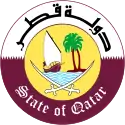
.svg.png.webp)
.svg.png.webp)

